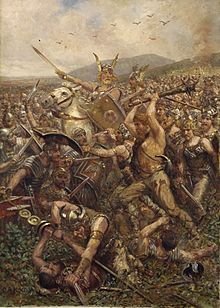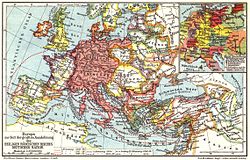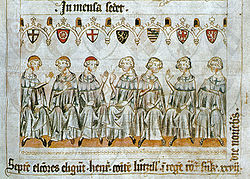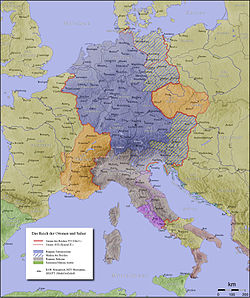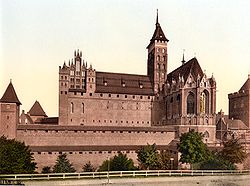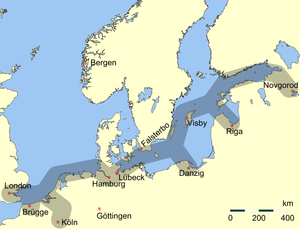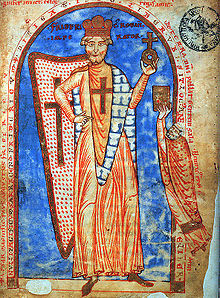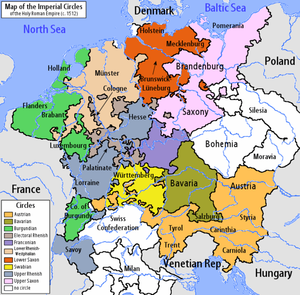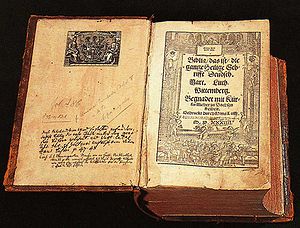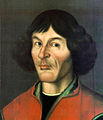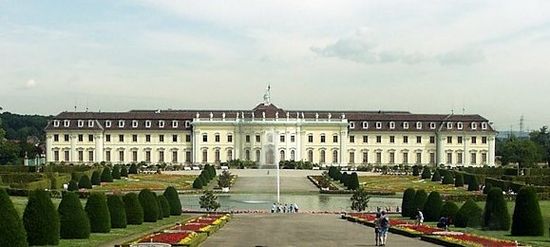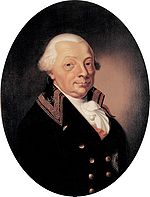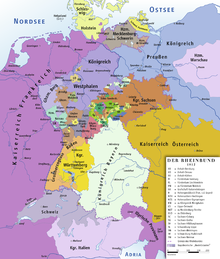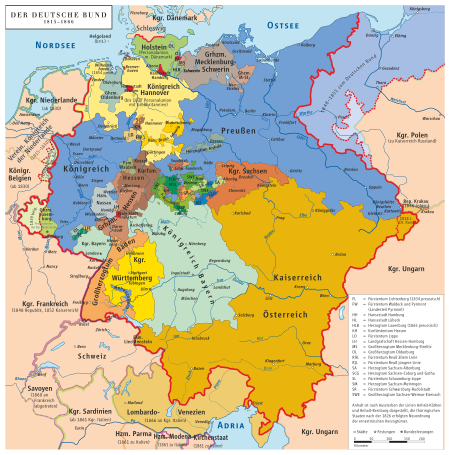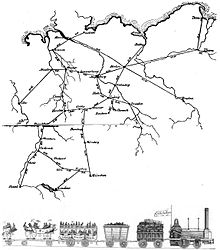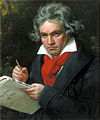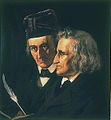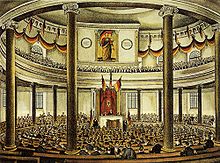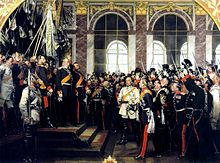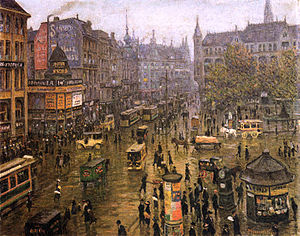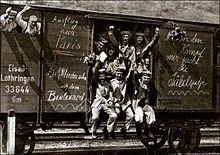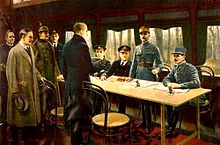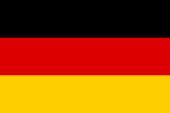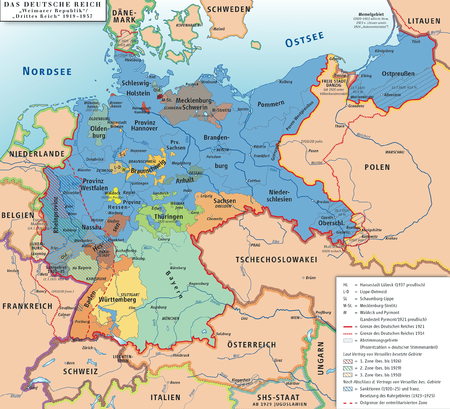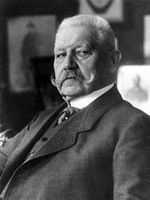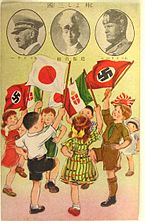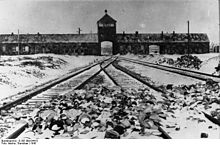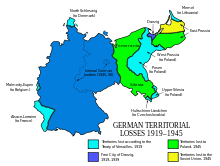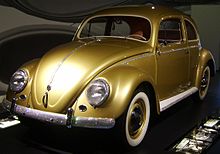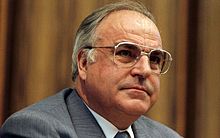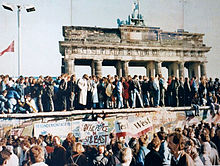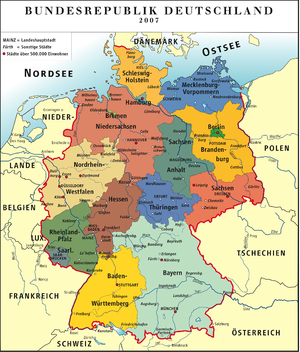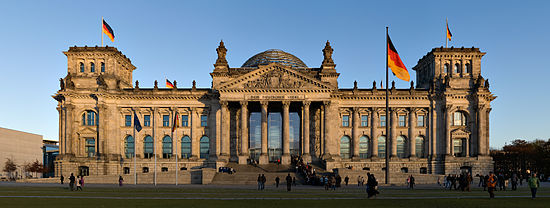
History of Germany
Did you know...
SOS Children volunteers helped choose articles and made other curriculum material With SOS Children you can choose to sponsor children in over a hundred countries
The concept of Germany as a distinct region in central Europe can be traced to Roman commander Julius Caesar, who referred to the unconquered area east of the Rhine as Germania, thus distinguishing it from Gaul (France), which he had conquered. The victory of the Germanic tribes in the Battle of the Teutoburg Forest (AD 9) prevented annexation by the Roman Empire. Following the fall of the Roman Empire, the Franks conquered the other West Germanic tribes. When the Frankish Empire was divided among Charlemagne's heirs in 843, the eastern part became East Francia. In 962, Otto I became the first emperor of the Holy Roman Empire, the medieval German state.
In the High Middle Ages, the dukes and princes of the empire gained power at the expense of the emperors. Martin Luther led the Protestant Reformation against the Catholic Church after 1517, as the northern states became Protestant, while the southern states remained Catholic. The two parts of the Holy Roman Empire clashed in the Thirty Years' War (1618–1648), which was ruinous to the twenty million civilians. 1648 marked the effective end of the Holy Roman Empire and the beginning of the modern nation-state system, with Germany divided into numerous independent states, such as Prussia, Bavaria and Saxony.
After the French Revolution and the Napoleonic Wars (1803–1815), feudalism fell away and liberalism and nationalism clashed with reaction. The 1848 March Revolution failed. The Industrial Revolution modernized the German economy, led to the rapid growth of cities and to the emergence of the Socialist movement in Germany. Prussia, with its capital Berlin, grew in power. German universities became world-class centers for science and the humanities, while music and the arts flourished. Unification was achieved with the formation of the German Empire in 1871 under the leadership of Prussian Chancellor Otto von Bismarck. The new Reichstag, an elected parliament, had only a limited role in the imperial government.
By 1900, Germany's economy matched Britain's, allowing colonial expansion and a naval race. Germany led the Central Powers in the First World War (1914–1918) against France, Great Britain, Russia and (by 1917) the United States. Defeated and partly occupied, Germany was forced to pay war reparations by the Treaty of Versailles and was stripped of its colonies as well as Polish areas and Alsace-Lorraine. The German Revolution of 1918–19 deposed the emperor and the kings, leading to the establishment of the Weimar Republic, an unstable parliamentary democracy.
In the early 1930s, the worldwide Great Depression hit Germany hard, as unemployment soared and people lost confidence in the government. In 1933, the Nazis under Adolf Hitler came to power and established a totalitarian regime. Political opponents were killed or imprisoned. Nazi Germany's aggressive foreign policy took control of Austria and parts of Czechoslovakia, and its invasion of Poland initiated the Second World War. After forming a pact with the Soviet Union in 1939, Hitler and Stalin divided Eastern Europe. After a "phoney war" in spring 1940 the German blitzkrieg swept Scandinavia, the Low Countries and France, giving Germany control of nearly all of Western Europe. Only Britain stood opposed. Hitler invaded the Soviet Union in June 1941, a reach too far. The systematic genocide program known as The Holocaust killed six million Jews in Germany and German-occupied areas, as well as five million Poles, Romanies, Slavs, Soviets, and others. In 1941, however, the German invasion of the Soviet Union faltered, and after the United States entered the war, Britain became the base for massive Anglo-American bombings of German cities. Germany fought the war on multiple fronts through 1942–1943. Following the Allied invasion of Normandy (June 1944), the German army was pushed back on all fronts until the final collapse in May 1945.
Under occupation by the Allies, German territories were split off, denazification took place, and the Cold War resulted in the division of the country into democratic West Germany and communist East Germany. Millions of ethnic Germans fled from Communist areas into West Germany, which experienced rapid economic expansion, and became the dominant economy in Western Europe. West Germany was rearmed in the 1950s under the auspices of NATO, but without access to nuclear weapons. The Franco-German friendship became the basis for the political integration of Western Europe in the European Union.
In 1989, the Berlin Wall was destroyed, the Soviet Union collapsed and East Germany was reunited with West Germany in 1990.
In 1998–1999, Germany was one of the founding countries of the Eurozone. Germany remains one of the economic powerhouses of Europe, contributing about one quarter of the Eurozone's annual gross domestic product. In the early 2010s, Germany played a critical role in trying to resolve the escalating Euro crisis, especially regarding Greece and other Southern European nations.
Germanic tribes, 750 BCE-768 CE
Migration and conquest
The ethnogenesis of the Germanic tribes is assumed to have occurred during the Nordic Bronze Age, or at the latest during the Pre-Roman Iron Age. From southern Scandinavia and northern Germany, the tribes began expanding south, east and west in the 1st century BC, coming into contact with the Celtic tribes of Gaul, as well as Iranian, Baltic, and Slavic tribes in Central Europe.
Little is known about early Germanic history, except through their recorded interactions with the Roman Empire, etymological research and archaeological finds.
In the first years of the 1st century, Roman legions conducted a long campaign in Germania, the area north of the Upper Danube and east of the Rhine, in an attempt to expand the Empire's frontiers and shorten its frontier line. They subdued several Germanic tribes, such as the Cherusci. The tribes became familiar with Roman tactics of warfare while maintaining their tribal identity. In 9 AD, a Cherusci chieftain named Arminius defeated a Roman army in the Battle of the Teutoburg Forest, a victory credited with stopping the Roman advance into Germanic territories and forming the birth of German history. Modern Germany, east of the Rhine, remained outside the Roman Empire. By AD 100, the time of Tacitus's Germania, Germanic tribes settled along the Roman frontier at the Rhine and the Danube (the Limes Germanicus), occupying most of the area of modern Germany; however, Austria, southern Bavaria, and the western Rhineland were Roman provinces.
The 3rd century saw the emergence of a number of large West Germanic tribes: Alamanni, Franks, Bavarii, Chatti, Saxons, Frisii, Sicambri, and Thuringii. Around 260, the Germanic peoples broke through the Limes and the Danube frontier into Roman-controlled lands.
Seven large German-speaking tribes – the Visigoths, Ostrogoths, Vandals, Burgundians, Lombards, Saxons and Franks – moved west and took part in the Decline of the Roman Empire and transformation of the old Western Roman Empire.
The unoccupied part of present Germany was invaded by the Huns at the end of the 4th century and led to the beginning of the Migration Period. Hunnic hegemony of Germany lasted until 469.
The Stem Duchies and Marches
Stem Duchies (tribal duchies) in Germany were mainly the areas of the old German tribes of the region, especially in the east.
In the 5th cent, the Völkerwanderung (or Germanic migrations) brought a number of Barbarian tribes into the failing Roman Empire. Tribes that became stem duchies were originally the Alamanni, the Thuringii, the Saxons, the Franks, the Burgundians, and the Rugii. In contrast to later duchies, these entities were not defined by strict administrative boundaries but by the area of settlement of major Germanic tribes. Over the next few centuries, some tribes warred, migrated, and merged. All these tribes in Germania were eventually subjugated by the Franks. However, remnants of several stem duchies survive today as states or regions in modern Western Europe countries: German states such as Bavaria and Saxony, German regions like Swabia, and French régions such as of Burgundy, and Lorraine.
Germans in the east also founded a series of border counties or Marches. To the north, these included Lusatia, the North March that would become Brandenburg and the heart of Prussia, and the Billung March. In the south, the marches included Carniola, Styria, and the March of Austria that would become Austria.
Frankish Empire
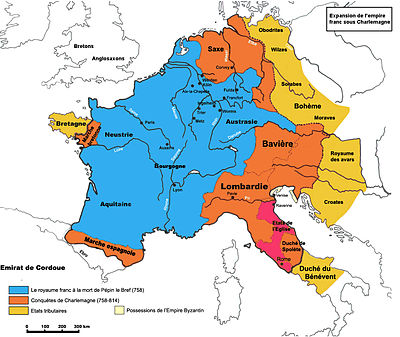
Blue = realm of Pippin III in 758,
Red = expansion under Charlemagne until 814,
Yellow = marches and dependencies
After the fall of the Western Roman Empire, the Franks created an empire under the Merovingian kings and subjugated the other Germanic tribes. The Merovingian kings of the Germanic Franks conquered northern Gaul in 486 AD. Swabia became a duchy under the Frankish Empire in 496, following the Battle of Tolbiac; in 530 Saxons and Franks destroyed the Kingdom of Thuringia. In the 5th and 6th centuries the Merovingian kings conquered several other Germanic tribes and kingdoms. King Chlothar I (558–561) ruled the greater part of what is now Germany and made expeditions into Saxony, while the Southeast of modern Germany was still under influence of the Ostrogoths. Saxons inhabited the area down to the Unstrut River.
Regions of the Frankish Empire were placed under the control of autonomous dukes of mixed Frankish and native blood. Frankish Colonists were encouraged to move to the newly conquered territories. While the local Germanic tribes were allowed to preserve their laws, they were pressured into becoming Christians.
The German territories became part of Austrasia (meaning "eastern land"), the northeastern portion of the Kingdom of the Merovingian Franks. As a whole, Austrasia comprised parts of present day France, Germany, Belgium, Luxembourg and the Netherlands. After the death of the Frankish king Clovis I in 511, his four sons partitioned his kingdom including Austrasia. Authority over Austrasia passed back and forth from autonomy to kingly subjugation, as Frankish lands were alternately united and subdivided by the Merovingian kings.
In 718, Charles Martel, the Franconian Mayor of the Palace, made war against Saxony because of its help for the Neustrians. His son Carloman started a new war against Saxony in 743, because the Saxons gave aid to Duke Odilo of Bavaria.
In 751 Pippin III, Mayor of the Palace under the Merovingian king, himself assumed the title of king and was anointed by the Church. Now the Frankish kings were set up as protectors of the pope, and Charles the Great launched a decades-long military campaign against their heathen rivals, the Saxons and the Avars. The campaigns and insurrections of the Saxon Wars lasted from 772 to 804. The Saxons and Avars were eventually overwhelmed, the people were forcibly converted to Christianity, and the lands were annexed by the Carolingian Empire.
Middle Ages
Charlemagne
After the 768 death of Frankish King Pepin the Short, his son Charles consolidated his control over his kingdom and became known as "Charles the Great" or "Charlemagne." From 771 until his death in 814, Charlemagne extended the Carolingian empire into northern Italy and the territories of all west Germanic peoples, including the Saxons and the Bajuwari (Bavarians). In 800, Charlemagne's authority was confirmed by his coronation as Holy Roman Emperor by the pope on Christmas Day in Rome. Imperial strongholds (Kaiserpfalzen) became economic and cultural centres, of which Aachen was the most famous.
Fighting among Charlemagne's grandchildren caused the Carolingian empire to be partitioned into several parts by the Treaty of Verdun (843), the Treaty of Meerssen (870), and the Treaty of Ribemont. The German region developed out of the East Frankish kingdom, East Francia. From 919 to 936, the Germanic peoples – Franks, Saxons, Swabians, and Bavarians – were united under Henry the Fowler, Duke of Saxony, who took the title of king. For the first time, the term "Kingdom (Empire) of the Germans" ( Regnum Teutonicorum) was applied to a Frankish kingdom, although Teutonicorum at its founding originally meant something closer to "Realm of the Germanic peoples" or "Germanic Realm" than "realm of the Germans".
Otto the Great
In 936, Otto I the Great was crowned as king at Aachen; his coronation as emperor by the Pope at Rome in 962 inaugurated what became later known as the Holy Roman Empire, which became to be identified with Germany. Otto strengthened the royal authority by re-asserting the old Carolingian rights over ecclesiastical appointments. Otto wrested from the nobles the powers of appointment of the bishops and abbots, who controlled large land holdings. Additionally, Otto revived the old Carolingian program of appointing missionaries in the border lands. Otto continued to support celibacy for the higher clergy, so ecclesiastical appointments never became hereditary. By granting land to the abbotts and bishops he appointed, Otto actually made these bishops into "princes of the Empire" ( Reichsfürsten); in this way, Otto was able to establish a national church. Outside threats to the kingdom were contained with the decisive defeat of the Hungarian Magyars at the Battle of Lechfeld in 955. The Slavs between the Elbe and the Oder rivers were also subjugated. Otto marched on Rome and drove John XII from the papal throne and for years controlled the election of the pope, setting a firm precedent for imperial control of the papacy for years to come.
During the reign of Conrad II's son, Henry III (1039 to 1056), the empire supported the Cluniac reforms of the Church – the Peace of God, prohibition of simony (the purchase of clerical offices), and required celibacy of priests. Imperial authority over the Pope reached its peak. In the Investiture Controversy which began between Henry IV and Pope Gregory VII over appointments to ecclesiastical offices, the emperor was compelled to submit to the Pope at Canossa in 1077, after having been excommunicated. In 1122 a temporary reconciliation was reached between Henry V and the Pope with the Concordat of Worms. The consequences of the investiture dispute were a weakening of the Ottonian church (Reichskirche), and a strengthening of the Imperial secular princes.
The time between 1096 and 1291 was the age of the crusades. Knightly religious orders were established, including the Knights Templar, the Knights of St John ( Knights Hospitaller), and the Teutonic Order.
The term sacrum imperium (Holy Empire) was first used under Friedrich I, documented first in 1157.
Hanseatic League
Long-distance trade in the Baltic intensified, as the major trading towns became drawn together in the Hanseatic League, under the leadership of Lübeck. The Hanseatic League was a business alliance of trading cities and their guilds that dominated trade along the coast of Northern Europe. Each of the Hanseatic cities had its own legal system and a degree of political autonomy. The chief cities were Cologne on the Rhine River, Hamburg and Bremen on the North Sea, and Lübeck on the Baltic. The League flourished from 1200 to 1500, and continued with lesser importance after that.
Eastward expansion
The German colonisation and the chartering of new towns and villages began into largely Slav-inhabited territories east of the Elbe, such as Bohemia, Silesia, Pomerania, and Livonia. Beginning in 1226, the Teutonic Knights began their conquest of Prussia. The native Baltic Prussians were conquered and Christianized by the Knights with much warfare, and numerous German towns were established along the eastern shore of the Baltic Sea.
Church and state
Henry V (1086–1125), great-grandson of Conrad II, became Holy Roman Emperor in 1106 in the midst of a civil war. Hoping to gain complete control over the church inside the Empire, Henry V appointed Adalbert of Saarbrücken as the powerful archbishop of Mainz in 1111. Adalbert began to assert the powers of the Church against secular authorities, that is, the Emperor. This precipitated the "Crisis of 1111", part of the long-term Investiture Controversy. In 1137 the magnates turned back to the Hohenstaufen family for a candidate, Conrad III. Conrad III tried to divest Henry the Proud of his two duchies – Bavaria and Saxony – leading to war in southern Germany as the Empire divided into two factions. The first faction called themselves the " Welfs" or "Guelphs" after Henry the Proud's family, which was the ruling dynasty in Bavaria; the other faction was known as the "Waiblings." In this early period, the Welfs generally represented ecclesiastical independence under the papacy plus "particularism" (a strengthening of the local duchies against the central imperial authority). The Waiblings, on the other hand, stood for control of the Church by a strong central Imperial government.
Between 1152 and 1190, during the reign of Frederick I (Barbarossa), of the Hohenstaufen dynasty, an accommodation was reached with the rival Guelph party by the grant of the duchy of Bavaria to Henry the Lion, duke of Saxony. Austria became a separate duchy by virtue of the Privilegium Minus in 1156. Barbarossa tried to reassert his control over Italy. In 1177 a final reconciliation was reached between the emperor and the Pope in Venice.
In 1180, Henry the Lion was outlawed; Saxony was divided, and Bavaria was given to Otto of Wittelsbach. (Otto founded the Wittelsbach dynasty, which was to rule Bavaria until 1918.)
From 1184 to 1186, the Hohenstaufen empire under Frederick I Barbarossa reached its peak in the Reichsfest (imperial celebrations) held at Mainz and the marriage of his son Henry in Milan to the Norman princess Constance of Sicily. The power of the feudal lords was undermined by the appointment of "ministerials" (unfree servants of the Emperor) as officials. Chivalry and the court life flowered, leading to a development of German culture and literature (see Wolfram von Eschenbach).
Between 1212 and 1250 Frederick II established a modern, professionally administered state from his base in Sicily. He resumed the conquest of Italy, leading to further conflict with the Papacy. In the Empire, extensive sovereign powers were granted to ecclesiastical and secular princes, leading to the rise of independent territorial states. The struggle with the Pope sapped the Empire's strength, as Frederick II was excommunicated three times. After his death, the Hohenstaufen dynasty fell, followed by an interregnum during which there was no Emperor.
The failure of negotiations between Emperor Louis IV and the papacy led in 1338 to the declaration at Rhense by six electors to the effect that election by all or the majority of the electors automatically conferred the royal title and rule over the empire, without papal confirmation. As result, the monarch was no longer subject to papal approbation and became increasingly dependent on the favour of the electors. Between 1346 and 1378 Emperor Charles IV of Luxembourg, king of Bohemia, sought to restore the imperial authority. The Golden Bull of 1356 stipulated that in future the emperor was to be chosen by four secular electors and three spiritual electors. The secular electors were the King of Bohemia, the Count Palatine of the Rhine, the Duke of Saxony, and the Margrave of Brandenburg; the three spiritual electors were the Archbishops of Mainz, Trier, and Cologne.

Around 1350 Germany and almost the whole of Europe were ravaged by the Black Death. Jews were persecuted on religious and economic grounds; many fled to Poland. The Black Death is estimated to have killed 30–60 percent of Europe's population[3] in the 14th century.
Change and reform
After the disasters of the 14th century – war, plague, and schism – early-modern European society gradually came into being as a result of economic, religious, and political changes. A money economy arose which provoked social discontent among knights and peasants. Gradually, a proto-capitalistic system evolved out of feudalism. The Fugger family gained prominence through commercial and financial activities and became financiers to both ecclesiastical and secular rulers. The knightly classes found their monopoly on arms and military skill undermined by the introduction of mercenary armies and foot soldiers. Predatory activity by "robber knights" became common.
From 1438 the Habsburgs, who controlled most of the southeast of the Empire (more or less modern-day Austria and Slovenia, and Bohemia and Moravia after the death of King Louis II in 1526), maintained a constant grip on the position of the Holy Roman Emperor until 1806 (with the exception of the years between 1742 and 1745). This situation, however, gave rise to increased disunity among the Holy Roman Empire's territorial rulers and prevented sections of the country from coming together to form nations in the manner of France and England.
During his reign from 1493 to 1519, Maximilian I tried to reform the Empire. An Imperial supreme court (Reichskammergericht) was established, imperial taxes were levied, and the power of the Imperial Diet (Reichstag) was increased. The reforms, however, were frustrated by the continued territorial fragmentation of the Empire.
Towns and cities
The German lands had a population of about 5 or 6 million. The great majority were farmers, typically in a state of serfdom under the control of nobles and monasteries. A few towns were starting to emerge. From 1100, new towns were founded around imperial strongholds, castles, bishops' palaces, and monasteries. The towns began to establish municipal rights and liberties (see German town law). Several cities such as Cologne became Imperial Free Cities, which did not depend on princes or bishops, but were immediately subject to the Emperor. The towns were ruled by patricians: merchants carrying on long-distance trade. Craftsmen formed guilds, governed by strict rules, which sought to obtain control of the towns; a few were open to women. Society was divided into sharply demarcated classes: the clergy, physicians, merchants, various guilds of artisans, and peasants; full citizenship was not available to paupers. Political tensions arose from issues of taxation, public spending, regulation of business, and market supervision, as well as the limits of corporate autonomy.
Cologne's central location on the Rhine river placed it at the intersection of the major trade routes between east and west and was the basis of Cologne's growth. The economic structures of medieval and early modern Cologne were characterized by the city's status as a major harbour and transport hub upon the Rhine. It was the seat of the archbishops, who ruled the surrounding area and (from 1248 to 1880) built the great Cologne Cathedral, with sacred relics that made it a destination for many worshippers. By 1288 the city had secured its independence from the archbishop (who relocated to Bonn), and was ruled by its burghers.
Science and culture
In the 12th century, German Benedictine abbess Hildegard von Bingen (1098–1179) wrote several influential theological, botanical, and medicinal texts, as well as letters, liturgical songs, poems, and arguably the oldest surviving morality play, while supervising brilliant miniature Illuminations. Ca. 100 years later, Walther von der Vogelweide (c. 1170-c. 1230) became the most celebrated of the Middle High German lyric poets.
Around 1439, Johannes Gutenberg, a citizen of Mainz, was the first European to use movable type printing and became the global inventor of the printing press, thereby starting the Printing Revolution. Gutenberg's inventions and works (such as the Gutenberg Bible) would play key roles for the development of the Reformation and the Scientific Revolution.
Around the transition from the 15th to the 16th century, Albrecht Dürer from Nuremberg established his reputation across Europe as painter, printmaker, mathematician, engraver, and theorist when he was still in his twenties and secured his reputation as one of the most important figures of the Northern Renaissance.
The addition Nationis Germanicæ (of German Nation) to the emperor's title appeared first in the 15th century: in a 1486 law decreed by Frederick III and in 1512 in reference to the Imperial Diet in Cologne by Maximilian I. By then, the emperors had lost their influence in Italy and Burgundy. In 1525, the Heilbronn reform plan – the most advanced document of the German Peasants' War (Deutscher Bauernkrieg) – referred to the Reich as von Teutscher Nation (of German nation).
-
Johannes Gutenberg (c. 1398–1468)
Early modern Germany

Reformation
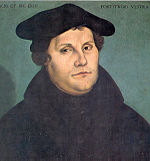
In the early 16th century there was much discontent occasioned by abuses such as indulgences in the Catholic Church, and a general desire for reform.
In 1517 the Reformation began with the publication of Martin Luther's 95 Theses; he had posted them in the town square, and gave copies of them to German nobles, but it is debated whether he nailed them to the church door in Wittenberg as is commonly said. The list detailed 95 assertions Luther believed to show corruption and misguidance within the Catholic Church. One often cited example, though perhaps not Luther's chief concern, is a condemnation of the selling of indulgences; another prominent point within the 95 Theses is Luther's disagreement both with the way in which the higher clergy, especially the pope, used and abused power, and with the very idea of the pope.
In 1521 Luther was outlawed at the Diet of Worms. But the Reformation spread rapidly, helped by the Emperor Charles V's wars with France and the Turks. Hiding in the Wartburg Castle, Luther translated the Bible from Latin to German, establishing the basis of the German language. A curious fact is that Luther spoke a dialect which had minor importance in the German language of that time. After the publication of his Bible, his dialect suppressed the others and evolved into what is now the modern German.
In 1524 the German Peasants' War broke out in Swabia, Franconia and Thuringia against ruling princes and lords, following the preachings of Reformist priests. But the revolts, which were assisted by war-experienced noblemen like Götz von Berlichingen and Florian Geyer (in Franconia), and by the theologian Thomas Münzer (in Thuringia), were soon repressed by the territorial princes. It is estimated that as many as 100,000 German peasants were massacred during the revolt, usually after the battles had ended. With the protestation of the Lutheran princes at the Imperial Diet of Speyer (1529) and rejection of the Lutheran "Augsburg Confession" at Augsburg (1530), a separate Lutheran church emerged.
From 1545 the Counter-Reformation began in Germany. The main force was provided by the Jesuit order, founded by the Spaniard Ignatius of Loyola. Central and northeastern Germany were by this time almost wholly Protestant, whereas western and southern Germany remained predominantly Catholic. In 1547, Holy Roman Emperor Charles V defeated the Schmalkaldic League, an alliance of Protestant rulers.
The Peace of Augsburg in 1555 brought recognition of the Lutheran faith. But the treaty also stipulated that the religion of a state was to be that of its ruler ( Cuius regio, eius religio).
In 1556 Charles V abdicated. The Habsburg Empire was divided, as Spain was separated from the Imperial possessions.
In 1608/1609 the Protestant Union and the Catholic League were formed.
Thirty Years War
From 1618 to 1648 the Thirty Years' War ravaged in the Holy Roman Empire. The causes were the conflicts between Catholics and Protestants, the efforts by the various states within the Empire to increase their power and the Catholic Emperor's attempt to achieve the religious and political unity of the Empire. The immediate occasion for the war was the uprising of the Protestant nobility of Bohemia against the emperor, but the conflict was widened into a European War by the intervention of King Christian IV of Denmark (1625–29), Gustavus Adolphus of Sweden (1630–48) and France under Cardinal Richelieu. Germany became the main theatre of war and the scene of the final conflict between France and the Habsburgs for predominance in Europe.
The fighting often was out of control, with marauding bands of hundreds or thousands of starving soldiers spreading plague, plunder, and murder. The armies that were under control moved back and forth across the countryside year after year, levying heavy taxes on cities, and seizing the animals and food stocks of the peasants without payment. The enormous social disruption over three decades caused a dramatic decline in population because of killings, disease, crop failures, declining birth rates and random destruction, and the out-migration of terrified people. One estimate shows a 38% drop from 16 million people in 1618 to 10 million by 1650, while another shows "only" a 20% drop from 20 million to 16 million. The Altmark and Württemberg regions were especially hard hit. It took generations for Germany to fully recover.
The war ended in 1648 with the Peace of Westphalia. Alsace was permanently lost to France, Pomerania was temporarily lost to Sweden, and the Netherlands officially left the Empire. Imperial power declined further as the states' rights were increased.
Culture and literacy
The German population reached about twenty million people, the great majority of whom were peasant farmers.
The Reformation was a triumph of literacy and the new printing press. Luther's translation of the Bible into German was a decisive moment in the spread of literacy, and stimulated as well the printing and distribution of religious books and pamphlets. From 1517 onward religious pamphlets flooded Germany and much of Europe. By 1530 over 10,000 publications are known, with a total of ten million copies. The Reformation was thus a media revolution. Luther strengthened his attacks on Rome by depicting a "good" against "bad" church. From there, it became clear that print could be used for propaganda in the Reformation for particular agendas. Reform writers used pre-Reformation styles, clichés, and stereotypes and changed items as needed for their own purposes. Especially effective were Luther's Small Catechism, for use of parents teaching their children, and Larger Catechism, for pastors. Using the German vernacular they expressed the Apostles' Creed in simpler, more personal, Trinitarian language. Illustrations in the newly translated Bible and in many tracts popularized Luther's ideas. Lucas Cranach the Elder (1472–1553), the great painter patronized by the electors of Wittenberg, was a close friend of Luther, and illustrated Luther's theology for a popular audience. He dramatized Luther's views on the relationship between the Old and New Testaments, while remaining mindful of Luther's careful distinctions about proper and improper uses of visual imagery.
Luther's German translation of the Bible was also decisive for the German language and its evolution from Early New High German to Modern Standard. His bible promoted the development of non-local forms of language and exposed all speakers to forms of German from outside their own area.
Science
Decisive scientific developments took place during the 16th and 17th centuries, especially in the fields of astronomy, mathematics and physics. In 1543, astronomer Nicolaus Copernicus from Toruń (Thorn) published his work De revolutionibus orbium coelestium and became the first person to formulate a comprehensive heliocentric cosmology that displaced the Earth from the centre of the universe. Almost 70 years after Copernicus's death and building on his theories, astronomer Johannes Kepler from Stuttgart was a leader in the 17th century scientific revolution. He is best known for his laws of planetary motion. His works Astronomia nova and Harmonices Mundi were further codified by later astronomers. These works also influenced contemporary Italian scientist Galileo Galilei and provided one of the foundations for Englishman Isaac Newton's theory of universal gravitation.
-
Nicolaus Copernicus (1473–1543)
-
Johannes Kepler (1571–1630)
1648–1815
From 1640, Brandenburg-Prussia had started to rise under the Great Elector, Frederick William. The Peace of Westphalia in 1648 strengthened it even further, through the acquisition of East Pomerania. From 1713 to 1740, King Frederick William I, also known as the "Soldier King", established a highly centralized, militarized state with a heavily rural population of about three million (compared to the nine million in Austria).
In terms of the boundaries of 1914, Germany in 1700 had a population of 16 million, increasing slightly to 17 million by 1750, and growing more rapidly to 24 million by 1800. Wars continued, but they were no longer so devastating to the civilian population; famines and major epidemics did not occur, but increased agricultural productivity led to a higher birth rate, and a lower death rate.
Wars
Louis XIV of France conquered parts of Alsace and Lorraine (1678–1681), and had invaded and devastated the Electorate of the Palatinate (1688–1697) in the War of Palatinian Succession. Louis XIV benefited from the Empire's problems with the Turks, which were menacing Austria. Louis XIV ultimately had to relinquish the Electorate of the Palatinate.

Afterwards Hungary was reconquered from the Turks; Austria, under the Habsburgs, developed into a great power.
In the War of Austrian Succession (1740–1748) Maria Theresa fought successfully for recognition of her succession to the throne. But in the Silesian Wars and in the Seven Years' War she had to cede 95 percent of Silesia to Frederick II, the Great, of Prussia. After the Peace of Hubertsburg in 1763 between Austria, Prussia and Saxony, Prussia became a European great power. This gave the start to the rivalry between Prussia and Austria for the leadership of Germany.
From 1763, against resistance from the nobility and citizenry, an " enlightened absolutism" was established in Prussia and Austria, according to which the ruler governed according to the best precepts of the philosophers. The economies developed and legal reforms were undertaken, including the abolition of torture and the improvement in the status of Jews. Emancipation of the peasants slowly began. Compulsory education was instituted.
In 1772–1795 Prussia took part in the partitions of Poland. Prussia occupied the western territories of the former Polish–Lithuanian Commonwealth that surrounded existing Prussian holdings. This occupation led to centuries of Polish resistance against Germanization.
Smaller states
Completely overshadowed by Prussia and Austria, the smaller German states were generally characterized by political lethargy and administrative inefficiency, often compounded by rulers who were more concerned with their mistresses and their hunting dogs than with the affairs of state. Bavaria was especially unfortunate in this regard; it was a rural land with very heavy debts and few growth centers. Saxony was in economically good shape, although its government was seriously mismanaged, and numerous wars had taken their toll. In Württemberg the duke lavished funds on palaces, mistresses, great celebration, and hunting expeditions. Many of the city-states of Germany were run by bishops, who in reality were from powerful noble families and showed scant interest in religion. None developed a significant reputation for good government.
In Hesse-Kassel, the Landgrave Frederick II, ruled 1760–1785 as an enlightened despot, and raised money by renting soldiers ( called "Hessians") to Great Britain to help fight the American Revolutionary War. He combined Enlightenment ideas with Christian values, cameralist plans for central control of the economy, and a militaristic approach toward diplomacy.
Hanover did not have to support a lavish court—its rulers were also kings of England and resided in London. George III, elector (ruler) from 1760 to 1820, never once visited Hanover. The local nobility who ran the country opened the University of Göttingen in 1737; it soon became a world-class intellectual centre.
Baden sported perhaps the best government of the smaller states. Karl Friedrich ruled well for 73 years (1738–1811) and was an enthusiast for The Enlightenment; he abolished serfdom in 1783.
The smaller states failed to form coalitions with each other, and were eventually overwhelmed by Prussia. Between 1807 and 1871, Prussia swallowed up many of the smaller states, with minimal protest, then went on to found the German Empire. In the process, Prussia became too heterogeneous, lost its identity, and by the 1930s had become an administrative shell of little importance.
Nobility
In a heavily agrarian society, land ownership played a central role. Germany's nobles, especially those in the East – called Junkers – dominated not only the localities, but also the Prussian court, and especially the Prussian army. Increasingly after 1815, a centralized Prussian government based in Berlin took over the powers of the nobles, which in terms of control over the peasantry had been almost absolute. To help the nobility avoid indebtedness, Berlin set up a credit institution to provide capital loans in 1809, and extended the loan network to peasants in 1849. When the German Empire was established in 1871, the Junker nobility controlled the army and the Navy, the bureaucracy, and the royal court; they generally set governmental policies.
Peasants and rural life
Peasants continued to centre their lives in the village, where they were members of a corporate body and help manage the community resources and monitor the community life. In the East, they were serfs who were bound permanently to parcels of land. In most of Germany, farming was handled by tenant farmers who paid rents and obligatory services to the landlord, who was typically a nobleman. Peasant leaders supervised the fields and ditches and grazing rights, maintained public order and morals, and supported a village court which handled minor offenses. Inside the family the patriarch made all the decisions, and tried to arrange advantageous marriages for his children. Much of the villages' communal life centered around church services and holy days. In Prussia, the peasants drew lots to choose conscripts required by the army. The noblemen handled external relationships and politics for the villages under their control, and were not typically involved in daily activities or decisions.
The emancipation of the serfs came in 1770–1830, beginning with Schleswig in 1780. The peasants were now ex-serfs and could own their land, buy and sell it, and move about freely. The nobles approved for now they could buy land owned by the peasants. The chief reformer was Baron vom Stein (1757–1831), who was influenced by The Enlightenment, especially the free market ideas of Adam Smith. The end of serfdom raised the personal legal status of the peasantry. A bank was set up so that landowner could borrow government money to buy land from peasants (the peasants were not allowed to use it to borrow money to buy land until 1850). The result was that the large landowners obtained larger estates, and many peasant became landless tenants, or moved to the cities or to America. The other German states imitated Prussia after 1815. In sharp contrast to the violence that characterized land reform in the French Revolution, Germany handled it peacefully. In Schleswig the peasants, who had been influenced by the Enlightenment, played an active role; elsewhere they were largely passive. Indeed, for most peasants, customs and traditions continued largely unchanged, including the old habits of deference to the nobles whose legal authority remains quite strong over the villagers. Although the peasants were no longer tied to the same land like serfs had been, the old paternalistic relationship in East Prussia lasted into the 20th century.
The agrarian reforms in northwestern Germany in the era 1770–1870 were driven by progressive governments and local elites. They abolished feudal obligations and divided collectively owned common land into private parcels and thus created a more efficient market-oriented rural economy. It produced increased productivity and population growth. It strengthened the traditional social order because wealthy peasants obtained most of the former common land, while the rural proletariat was left without land; many left for the cities or America. Meanwhile the division of the common land served as a buffer preserving social peace between nobles and peasants. In the east the serfs were emancipated but the Junker class maintained its large estates and monopolized political power.
Around 1800 the Catholic monasteries, which had large land holdings, were nationalized and sold off by the government. In Bavaria they had controlled 56% of the land.
Enlightenment

Before 1750 the German upper classes looked to France for intellectual, cultural and architectural leadership; French was the language of high society. By the mid-18th century the "Aufklärung" (The Enlightenment) had transformed German high culture in music, philosophy, science and literature. Christian Wolff (1679–1754) was the pioneer as a writer who expounded the Enlightenment to German readers; he legitimized German as a philosophic language.
Johann Gottfried von Herder (1744–1803) broke new ground in philosophy and poetry, as a leader of the Sturm und Drang movement of proto-Romanticism. Weimar Classicism ("Weimarer Klassik") was a cultural and literary movement based in Weimar that sought to establish a new humanism by synthesizing Romantic, classical, and Enlightenment ideas. The movement, from 1772 until 1805, involved Herder as well as polymath Johann Wolfgang von Goethe (1749–1832) and Friedrich Schiller (1759–1805), a poet and historian. Herder argued that every folk had its own particular identity, which was expressed in its language and culture. This legitimized the promotion of German language and culture and helped shape the development of German nationalism. Schiller's plays expressed the restless spirit of his generation, depicting the hero's struggle against social pressures and the force of destiny.
German music, sponsored by the upper classes, came of age under composers Johann Sebastian Bach (1685–1750), Joseph Haydn (1732–1809), and Wolfgang Amadeus Mozart (1756–1791).
In remote Königsberg philosopher Immanuel Kant (1724–1804) tried to reconcile rationalism and religious belief, individual freedom, and political authority. Kant's work contained basic tensions that would continue to shape German thought – and indeed all of European philosophy – well into the 20th century.
The German Enlightenment won the support of princes, aristocrats, and the middle classes, and it permanently reshaped the culture.
French Revolution 1789–1815
German reaction to the French Revolution was mixed at first. German intellectuals celebrated the outbreak, hoping to see the triumph of Reason and The Enlightenment. The royal courts in Vienna and Berlin denounced the overthrow of the king and the threatened spread of notions of liberty, equality, and fraternity. By 1793, the execution of the French king and the onset of the Terror disillusioned the Bildungsbürgertum (educated middle classes). Reformers said the solution was to have faith in the ability of Germans to reform their laws and institutions in peaceful fashion.
Europe was racked by two decades of war revolving around France's efforts to spread its revolutionary ideals, and the opposition of reactionary royalty. War broke out in 1792 as Austria and Prussia invaded France, but were defeated at the Battle of Valmy (1792). The German lands saw armies marching back and forth, bringing devastation (albeit on a far lower scale than the Thirty Years' War, almost two centuries before), but also bringing new ideas of liberty and civil rights for the people. Prussia and Austria ended their failed wars with France but (with Russia) partitioned Poland among themselves in 1793 and 1795. The French took control of the Rhineland, imposed French-style reforms, abolished feudalism, established constitutions, promoted freedom of religion, emancipated Jews, opened the bureaucracy to ordinary citizens of talent, and forced the nobility to share power with the rising middle class. Napoleon created the Kingdom of Westphalia (1807–1813) as a model state. These reforms proved largely permanent and modernized the western parts of Germany. When the French tried to impose the French language, German opposition grew in intensity. A Second Coalition of Britain, Russia, and Austria then attacked France but failed. Napoleon established direct or indirect control over most of western Europe, including the German states apart from Prussia and Austria. The old Holy Roman Empire was little more than a farce; Napoleon simply abolished it in 1806 while forming new countries under his control. In Germany Napoleon set up the " Confederation of the Rhine," comprising most of the German states except Prussia and Austria.
Prussia tried to remain neutral while imposing tight controls on dissent, but with German nationalism sharply on the rise, the small nation blundered by going to war with Napoleon in 1806. Its economy was weak, its leadership poor, and the once mighty Prussian army was a hollow shell. Napoleon easily crushed it at the Battle of Jena (1806). Napoleon occupied Berlin, and Prussia paid dearly. Prussia lost its recently acquired territories in western Germany, its army was reduced to 42,000 men, no trade with Britain was allowed, and Berlin had to pay Paris heavy reparations and fund the French army of occupation. Saxony changed sides to support Napoleon and join his Confederation of the Rhine; its elector was rewarded with the title of king and given a slice of Poland taken from Prussia.
After Napoleon's fiasco in Russia in 1812, including the deaths of many Germans in his invasion army, Prussia joined with Russia. Major battles followed in quick order, and when Austria switched sides to oppose Napoleon his situation grew tenuous. He was defeated in a great Battle of Leipzig in late 1813, and Napoleon's empire started to collapse. One after another the German states switched to oppose Napoleon, but he rejected peace terms. Allied armies invaded France in early 1814, Paris fell, and in April Napoleon surrendered. He returned for 100 days in 1815, but was finally defeated by the British and German armies at Waterloo. Prussia was the big winner at the Vienna peace conference, gaining extensive territory.
German Confederation
The German Confederation (German: Deutscher Bund) was the loose association of 39 states created in 1815 to coordinate the economies of separate German-speaking countries. It acted as a buffer between the powerful states of Austria and Prussia. Britain approved of it because London felt that there was need for a stable, peaceful power in central Europe that could discourage aggressive moves by France or Russia. According to Lee (1985), most historians have judged the Confederation to be weak and ineffective, as well as an obstacle to German nationalist aspirations. It collapsed because the rivalry between Prussia and Austria (known as German dualism), warfare, the 1848 revolution, and the inability of the multiple members to compromise. It was replaced by the North German Confederation in 1866.
Society and economy
Population
The population of the German Confederation (excluding Austria) grew 60% from 1815 to 1865, from 21,000,000 to 34,000,000. The era saw the Demographic Transition take place in Germany. It was a transition from high birth rates and high death rates to low birth and death rates as the country developed from a pre-industrial to a modernized agriculture and supported a fast-growing industrialized urban economic system. In previous centuries, the shortage of land meant that not everyone could marry, and marriages took place after age 25. After 1815, increased agricultural productivity meant a larger food supply, and a decline in famines, epidemics, and malnutrition. This allowed couples to marry earlier, and have more children. Arranged marriages became uncommon as young people were now allowed to choose their own marriage partners, subject to a veto by the parents. The high birthrate was offset by a very high rate of infant mortality and emigration, especially after about 1840, mostly to the German settlements in the United States, plus periodic epidemics and harvest failures. The upper and middle classes began to practice birth control, and a little later so too did the peasants.
Industrialization
Before 1850 Germany lagged far behind the leaders in industrial development – Britain, France, and Belgium. In 1800, Germany's social structure was poorly suited to entrepreneurship or economic development. Domination by France during the era of the French Revolution (1790s to 1815), however, produced important institutional reforms. Reforms included the abolition of feudal restrictions on the sale of large landed estates, the reduction of the power of the guilds in the cities, and the introduction of a new, more efficient commercial law. Nevertheless, traditionalism remained strong in most of Germany. Until midcentury, the guilds, the landed aristocracy, the churches, and the government bureaucracies had so many rules and restrictions that entrepreneurship was held in low esteem, and given little opportunity to develop. From the 1830s and 1840s, Prussia, Saxony, and other states reorganized agriculture. The introduction of sugar beets, turnips, and potatoes yielded a higher level of food production, which enabled a surplus rural population to move to industrial areas. The beginnings of the industrial revolution in Germany came in the textile industry, and was facilitated by eliminating tariff barriers through the Zollverein, starting in 1834.
By midcentury, the German states were catching up. By 1900 Germany was a world leader in industrialization, along with Britain and the United States.
Urbanization
Industrialization brought rural Germans to the factories, mines and railways. The population in 1800 was heavily rural, with only 10% of the people living in communities of 5000 or more people, and only 2% living in cities of more than 100,000. After 1815, the urban population grew rapidly, due primarily to the influx of young people from the rural areas. Berlin grew from 172,000 in 1800, to 826,000 in 1870; Hamburg grew from 130,000 to 290,000; Munich from 40,000 to 269,000; and Dresden from 60,000 to 177,000. Offsetting this growth, there was extensive emigration, especially to the United States. Emigration totaled 480,000 in the 1840s, 1,200,000 in the 1850s, and 780,000 in the 1860s.
Railways
The takeoff stage of economic development came with the railroad revolution in the 1840s, which opened up new markets for local products, created a pool of middle managers, increased the demand for engineers, architects and skilled machinists and stimulated investments in coal and iron. Political disunity of three dozen states and a pervasive conservatism made it difficult to build railways in the 1830s. However, by the 1840s, trunk lines did link the major cities; each German state was responsible for the lines within its own borders. Economist Friedrich List summed up the advantages to be derived from the development of the railway system in 1841:
- As a means of national defence, it facilitates the concentration, distribution and direction of the army.
- It is a means to the improvement of the culture of the nation. It brings talent, knowledge and skill of every kind readily to market.
- It secures the community against dearth and famine, and against excessive fluctuation in the prices of the necessaries of life.
- It promotes the spirit of the nation, as it has a tendency to destroy the Philistine spirit arising from isolation and provincial prejudice and vanity. It binds nations by ligaments, and promotes an interchange of food and of commodities, thus making it feel to be a unit. The iron rails become a nerve system, which, on the one hand, strengthens public opinion, and, on the other hand, strengthens the power of the state for police and governmental purposes.
Lacking a technological base at first, the Germans imported their engineering and hardware from Britain, but quickly learned the skills needed to operate and expand the railways. In many cities, the new railway shops were the centres of technological awareness and training, so that by 1850, Germany was self-sufficient in meeting the demands of railroad construction, and the railways were a major impetus for the growth of the new steel industry. Observers found that even as late as 1890, their engineering was inferior to Britain’s. However, German unification in 1870 stimulated consolidation, nationalisation into state-owned companies, and further rapid growth. Unlike the situation in France, the goal was support of industrialisation, and so heavy lines crisscrossed the Ruhr and other industrial districts, and provided good connections to the major ports of Hamburg and Bremen. By 1880, Germany had 9,400 locomotives pulling 43,000 passengers and 30,000 tons of freight a day, and forged ahead of France.
Science and culture
German artists and intellectuals, heavily influenced by the French Revolution and by the great German poet and writer Johann Wolfgang von Goethe (1749–1832), turned to Romanticism after a period of Enlightenment. Philosophical thought was decisively shaped by Immanuel Kant (1724–1804). Ludwig van Beethoven (1770–1827) was the leading composer of Romantic music. His use of tonal architecture in such a way as to allow significant expansion of musical forms and structures was immediately recognized as bringing a new dimension to music. His later piano music and string quartets, especially, showed the way to a completely unexplored musical universe, and influenced Franz Schubert (1797–1828) and Robert Schumann (1810–1856). In opera, a new Romantic atmosphere combining supernatural terror and melodramatic plot in a folkloric context was first successfully achieved by Carl Maria von Weber (1786–1826) and perfected by Richard Wagner (1813–1883) in his Ring Cycle. The Brothers Grimm (1785–1863 & 1786–1859) not only wrote the popular Grimm's Fairy Tales, but were among the founding fathers of German philology and German studies.
At the universities high-powered professors developed international reputations, especially in the humanities led by history and philology, which brought a new historical perspective to the study of political history, theology, philosophy, language, and literature. With Georg Wilhelm Friedrich Hegel (1770–1831) in philosophy, Friedrich Schleiermacher (1768–1834) in theology and Leopold von Ranke (1795–1886) in history, the University of Berlin, founded in 1810, became the world's leading university. Von Ranke, for example, professionalized history and set the world standard for historiography. By the 1830s mathematics, physics, chemistry, and biology had emerged with world class science, led by Alexander von Humboldt (1769–1859) in natural science and Carl Friedrich Gauss (1777–1855) in mathematics. Young intellectuals often turned to politics, but their support for the failed Revolution of 1848 forced many into exile.
-
Immanuel Kant (1724–1804)
-
Johann Wolfgang von Goethe (1749–1832)
-
Ludwig van Beethoven (1770–1827)
-
Carl Friedrich Gauss (1777–1855)
-
Brothers Grimm (1785–1863 & 1786–1859)
Politics of restoration and revolution
German Confederation and the early 1800s
After the fall of Napoleon, Europe's statesmen convened in Vienna in 1815 for the reorganisation of European affairs, under the leadership of the Austrian Prince Metternich. The political principles agreed upon at this Congress of Vienna included the restoration, legitimacy and solidarity of rulers for the repression of revolutionary and nationalist ideas.
The German Confederation (German: Deutscher Bund) was founded, a loose union of 39 states (35 ruling princes and 4 free cities) under Austrian leadership, with a Federal Diet (German: Bundestag) meeting in Frankfurt am Main. It was a loose coalition that failed to satisfy most nationalists. The member states largely went their own way, and Austria had its own interests.
In 1819 a student radical assassinated the reactionary playwright August von Kotzebue, who had scoffed at liberal student organisations. In one of the few major actions of the German Confederation, Prince Metternich called a conference that issued the repressive Carlsbad Decrees, designed to suppress liberal agitation against the conservative governments of the German states. The Decrees terminated the fast-fading nationalist fraternities (German: Burschenschaften), removed liberal university professors, and expanded the censorship of the press. The decrees began the "persecution of the demagogues", which was directed against individuals who were accused of spreading revolutionary and nationalist ideas. Among the persecuted were the poet Ernst Moritz Arndt, the publisher Johann Joseph Görres and the "Father of Gymnastics" Ludwig Jahn.
In 1834 the Zollverein was established, a customs union between Prussia and most other German states, but excluding Austria. As industrialisation developed, the need for a unified German state with a uniform currency, legal system, and government became more and more obvious.
1848
Growing discontent with the political and social order imposed by the Congress of Vienna led to the outbreak, in 1848, of the March Revolution in the German states. In May the German National Assembly (the Frankfurt Parliament) met in Frankfurt to draw up a national German constitution.
But the 1848 revolution turned out to be unsuccessful: King Frederick William IV of Prussia refused the imperial crown, the Frankfurt parliament was dissolved, the ruling princes repressed the risings by military force, and the German Confederation was re-established by 1850. Many leaders went into exile, including a number who went to the United States and became a political force there.
1850s
The 1850s were a period of extreme political reaction. Dissent was vigorously suppressed, and many Germans emigrated to America following the collapse of the 1848 uprisings. Frederick William IV became extremely depressed and melancholy during this period, and was surrounded by men who advocated clericalism and absolute divine monarchy. The Prussian people once again lost interest in politics. Prussia not only expanded its territory but began to industrialize rapidly, while maintaining a strong agricultural base.
Bismarck takes charge, 1862–66
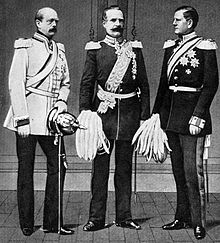
In 1857, the king had a stroke and his brother William became regent, then became King William I in 1861. Although conservative, William I was far more pragmatic. His most significant accomplishment was naming Otto von Bismarck as chancellor in 1862. The combination of Bismarck, Defense Minister Albrecht von Roon, and Field Marshal Helmut von Moltke set the stage for victories over Denmark, Austria, and France, and led to the unification of Germany. The obstacle to German unification was Austria, and Bismarck solved the problem with a series of wars that united the German states north of Austria.
In 1863–64, disputes between Prussia and Denmark grew over Schleswig, which was not part of the German Confederation, and which Danish nationalists wanted to incorporate into the Danish kingdom. The dispute led to the short Second War of Schleswig in 1864. Prussia, joined by Austria, easily defeated Denmark and occupied Jutland. The Danes were forced to cede both the duchy of Schleswig and the duchy of Holstein to Austria and Prussia. In the aftermath, the management of the two duchies caused escalating tensions between Austria and Prussia. The former wanted the duchies to become an independent entity within the German Confederation, while the latter wanted to annex them. The Seven Weeks War between Austria and Prussia broke out in June 1866. In July, the two armies clashed at Sadowa-Koniggratz (Bohemia) in an enormous battle involving half a million men. The Prussian breech-loading needle guns carried the day over the slow muzzle-loading rifles of the Austrians, who lost a quarter of their army in the battle. Austria ceded Venice to Italy, but Bismarck was deliberately lenient with the loser to keep alive a long-term alliance with Austria in a subordinate role. Now the French faced an increasingly strong Prussia.
North German Federation

In 1866, the German Confederation was dissolved. In its place the North German Federation (German Norddeutscher Bund) was established, under the leadership of Prussia. Austria was excluded, and the Austrian influence in Germany that had begun in the 15th century finally came to an end.
The North German Federation was a transitional organisation that existed from 1867 to 1871, between the dissolution of the German Confederation and the founding of the German Empire.
German Empire
Overview
After Germany was united by Otto von Bismarck into the "Second German Reich", he determined German politics until 1890. Bismarck tried to foster alliances in Europe, on one hand to contain France, and on the other hand to consolidate Germany's influence in Europe. On the domestic front Bismarck tried to stem the rise of socialism by anti-socialist laws, combined with an introduction of health care and social security. At the same time Bismarck tried to reduce the political influence of the emancipated Catholic minority in the Kulturkampf, literally "culture struggle". The Catholics only grew stronger, forming the Centre (Zentrum) Party. Germany grew rapidly in industrial and economic power, matching Britain by 1900. Its highly professional army was the best in the world, but the navy could never catch up with Britain's Royal Navy.
In 1888, the young and ambitious Kaiser Wilhelm II became emperor. He could not abide advice, least of all from the most experienced politician and diplomat in Europe, so he fired Bismarck. The Kaiser opposed Bismarck's careful foreign policy and wanted Germany to pursue colonialist policies, as Britain and France had been doing for decades, as well as build a navy that could match the British. The Kaiser promoted active colonization of Africa and Asia for those areas that were not already colonies of other European powers; his record was notoriously brutal and set the stage for genocide. The Kaiser took a mostly unilateral approach in Europe with as main ally the Austro-Hungarian Empire, and an arms race with Britain, which eventually led to the situation in which the assassination of the Austrian-Hungarian crown prince could spark off World War I.
Age of Bismarck
The new empire
Disputes between France and Prussia increased. In 1868, the Spanish queen Isabella II was expelled by a revolution, leaving that country's throne vacant. When Prussia tried to put a Hohenzollern candidate, Prince Leopold, on the Spanish throne, the French angrily protested. In July 1870, France declared war on Prussia (the Franco-Prussian War). The debacle was swift. A succession of German victories in northeastern France followed, and one French army was besieged at Metz. After a few weeks, the main army was finally forced to capitulate in the fortress of Sedan. French Emperor Napoleon III was taken prisoner and a republic hastily proclaimed in Paris. The new government, realising that a victorious Germany would demand territorial acquisitions, resolved to fight on. They began to muster new armies, and the Germans settled down to a grim siege of Paris. The starving city surrendered in January 1871, and the Prussian army staged a victory parade in it. France was forced to pay indemnities of 5 billion francs and cede Alsace-Lorraine. It was a bitter peace that would leave the French thirsting for revenge.
During the Siege of Paris, the German princes assembled in the Hall of Mirrors of the Palace of Versailles and proclaimed the Prussian King Wilhelm I as the "German Emperor" on 18 January 1871. The German Empire was thus founded, with the German states unified into a single economic, political, and administrative unit. The empire comprised 25 states, three of which were Hanseatic free cities. It was dubbed the "Little German" solution, since it excluded the Austrian territories and the Habsburgs. Bismarck, again, was appointed to serve as Chancellor.
The new empire was characterised by a great enthusiasm and vigor. There was a rash of heroic artwork in imitation of Greek and Roman styles, and the nation possessed a vigorous, growing industrial economy, while it had always been rather poor in the past. The change from the slower, more tranquil order of the old Germany was very sudden, and many, especially the nobility, resented being displaced by the new rich. And yet, the nobles clung stubbornly to power, and they, not the bourgeois, continued to be the model that everyone wanted to imitate. In imperial Germany, possessing a collection of medals or wearing a uniform was valued more than the size of one's bank account, and Berlin never became a great cultural centre as London, Paris, or Vienna were. The empire was distinctly authoritarian in tone, as the 1871 constitution gave the emperor exclusive power to appoint or dismiss the chancellor. He also was supreme commander-in-chief of the armed forces and final arbiter of foreign policy. But freedom of speech, association, and religion were nonetheless guaranteed by the constitution.
Bismarck's domestic policies as Chancellor of Germany were characterised by his fight against perceived enemies of the Protestant Prussian state. In the so-called Kulturkampf (1872–1878), he tried to limit the influence of the Roman Catholic Church and of its political arm, the Catholic Centre Party, through various measures—like the introduction of civil marriage—but without much success. The Kulturkampf antagonised many Protestants as well as Catholics, and was eventually abandoned. Millions of non-Germans subjects in the German Empire, like the Polish, Danish and French minorities, were discriminated against, and a policy of Germanisation was implemented.
Classes
Germany's middle class, based in the cities, grew exponentially, although it never gained the political power it had in France, Britain or the United States. The Association of German Women's Organizations (BDF) was established in 1894 to encompass the proliferating women's organizations that had sprung up since the 1860s. From the beginning the BDF was a bourgeois organization, its members working toward equality with men in such areas as education, financial opportunities, and political life. Working-class women were not welcome; they were organized by the Socialists.
The rise of the Socialist Workers' Party (later known as the Social Democratic Party of Germany, SPD), declared its aim to establish peacefully a new socialist order through the transformation of existing political and social conditions. From 1878, Bismarck tried to repress the social democratic movement by outlawing the party's organisation, its assemblies and most of its newspapers. When it finally was allowed to run candidates, the Social Democrats were stronger than ever.
Bismarck built on a tradition of welfare programs in Prussia and Saxony that began as early as the 1840s. In the 1880s he introduced old age pensions, accident insurance, medical care, and unemployment insurance that formed the basis of the modern European welfare state. His paternalistic programs won the support of German industry because its goals were to win the support of the working classes for the Empire and reduce the outflow of immigrants to America, where wages were higher but welfare did not exist. Bismarck further won the support of both industry and skilled workers by his high tariff policies, which protected profits and wages from American competition, although they alienated the liberal intellectuals who wanted free trade.
Kulturkampf
In 1871–1878, Bismarck launched the " Kulturkampf" in Prussia to reduce the power of the Catholic Church in public affairs, and keep the Poles under control. Thousands of priests and bishops were harassed or imprisoned, with large fines and closures of Catholic churches and schools. While the pope did control the selection of bishops, the Catholics supported unification and most of Bismarck's policies, and were angry at his systematic attacks.
Bismarck sought to appeal to liberals and Protestants but he failed because the Catholics were unanimous in their resistance and organized themselves to fight back politically, using their strength in other states besides Prussia. (The Kulturkampf did not extend to the other German states such as heavily Catholic Bavaria.) German nationalists feared the Polonization of the Prussian East. Bismarck saw the Kulturkampf as a means of stopping this trend, which was led by the Catholic clergy in West Prussia, Poznania and Silesia. The Poles were Catholics and subjected to harassment in the fields of education, occupations, business and public administration. German was declared to be the only official language, but in practice the Poles only adhered more closely to their traditions.
There was little or no violence, but the new Roman Catholic Centre Party won a quarter of the seats in the Reichstag (Imperial Parliament), and its middle position on most issues allowed it to play a decisive role in the formation of majorities. The culture war gave secularists and socialists an opportunity to attack all religions, an outcome that distressed the Protestants, including Bismarck, who was a devout pietistic Protestant. The Catholic anti-liberalism was led by Pope Pius IX; his death in 1878 allowed Bismarck to open negotiations with Pope Leo XIII, and led to the abandonment of the Kulturkampf in stages in the early 1880s.
Foreign policy
Bismarck's post-1871 foreign policy was conservative and basically aimed at security and preventing the dreaded scenario of a Franco-Russian alliance, which would trap Germany between the two in a war.
The League of Three Emperors (Dreikaisersbund) was signed in 1872 by Russia, Austria, and Germany. It stated that republicanism and socialism were common enemies and that the three powers would discuss any matters concerning foreign policy. Bismarck needed good relations with Russia in order to keep France isolated. In 1877–1878, Russia fought a victorious war with the Ottoman Empire and attempted to impose the Treaty of San Stefano on it. This upset the British in particular, as they were long concerned with preserving the Ottoman Empire and preventing a Russian takeover of the Bosphorus Strait. Germany hosted the Congress of Berlin (1878), whereby a more moderate peace settlement was agreed to. Germany had no direct interest in the Balkans, however, which was largely an Austrian and Russian sphere of influence, although King Carol of Romania was a German prince.
In 1879, Bismarck formed a Dual Alliance of Germany and Austria-Hungary, with the aim of mutual military assistance in the case of an attack from Russia, which was not satisfied with the agreement reached at the Congress of Berlin. The establishment of the Dual Alliance led Russia to take a more conciliatory stance, and in 1887, the so-called Reinsurance Treaty was signed between Germany and Russia: in it, the two powers agreed on mutual military support in the case that France attacked Germany, or in case of an Austrian attack on Russia. Russia turned its attention eastward to Asia and remained largely inactive in European politics for the next 25 years. In 1882, Italy joined the Dual Alliance to form a Triple Alliance. Italy wanted to defend its interests in North Africa against France's colonial policy. In return for German and Austrian support, Italy committed itself to assisting Germany in the case of a French military attack.
For a long time, Bismarck had refused to give in widespread public demands to give Germany "a place in the sun" through the acquisition of overseas colonies. In 1880 Bismarck gave way, and a number of colonies were established overseas. In Africa, these were Togo, the Cameroons, German South-West Africa, and German East Africa; in Oceania, they were German New Guinea, the Bismarck Archipelago, and the Marshall Islands. In fact, it was Bismarck himself who helped initiate the Berlin Conference of 1885. He did it to "establish international guidelines for the acquisition of African territory" (see Colonisation of Africa). This conference was an impetus for the "Scramble for Africa" and " New Imperialism".
Bismarck dismissed by new Kaiser
In 1888, the old emperor William I died at the age of 90. His son Frederick III, the hope of German liberals, succeeded him, but was already stricken with throat cancer and died three months later. Frederick's son Wilhelm II then became emperor at the age of 29. He was the antithesis of old, conservative Germans like Bismarck, addicted to the new imperialism that was taking place in Asia and Africa. Having a left arm withered by childhood polio, he was painfully insecure and desired above all to be loved by the people. He sought to make Germany a great world power with a navy to rival Britain's. Bismarck hoped to marginalise him just as he had marginalised his grandfather, but William II desired to be his own master. Bismarck's schemes to dominate the emperor and hold onto his own power failed, and he was forced to resign in March 1890.
Wilhelminian Era
Alliances and diplomacy
The young Kaiser Wilhelm sought aggressively to increasing Germany's influence in the world ( Weltpolitik). After the removal of Bismarck, foreign policy was in the hands of the erratic Kaiser, who played an increasingly reckless hand, and the powerful foreign office under the leadership of Friedrich von Holstein. The foreign office argued that: first, a long-term coalition between France and Russia had to fall apart; secondly, Russia and Britain would never get together; and, finally, Britain would eventually seek an alliance with Germany. Germany refused to renew its treaties with Russia. But Russia did form a closer relationship with France in the Dual Alliance of 1894, since both were worried about the possibilities of German aggression. Furthermore, Anglo–German relations cooled as Germany aggressively tried to build a new empire and engaged in a naval race with Britain; London refused to agree to the formal alliance that Germany sought. Berlin's analysis proved mistaken on every point, leading to Germany's increasing isolation and its dependence on the Triple Alliance, which brought together Germany, Austria-Hungary, and Italy. The Triple Alliance was undermined by differences between Austria and Italy, and in 1915 Italy switched sides.
Meanwhile the German Navy under Admiral Alfred von Tirpitz had ambitions to rival the great British Navy, and dramatically expanded its fleet in the early 20th century to protect the colonies and exert power worldwide. Tirpitz started a programme of warship construction in 1898. In 1890, Germany had gained the island of Heligoland in the North Sea from Britain in exchange for the eastern African island of Zanzibar, and proceeded to construct a great naval base there. This posed a direct threat to British hegemony on the seas, with the result that negotiations for an alliance between Germany and Britain broke down. The British, however, kept well ahead in the naval race by the introduction of the highly advanced new Dreadnought battleship in 1907.
In the First Moroccan Crisis of 1905, Germany nearly came to blows with Britain and France when the latter attempted to establish a protectorate over Morocco. The Germans were upset at having not been informed about French intentions, and declared their support for Moroccan independence. William II made a highly provocative speech regarding this. The following year, a conference was held in which all of the European powers except Austria-Hungary (by now little more than a German satellite) sided with France. A compromise was brokered by the United States where the French relinquished some, but not all, control over Morocco.
The Second Moroccan Crisis of 1911 saw another dispute over Morocco erupt when France tried to suppress a revolt there. Germany, still smarting from the previous quarrel, agreed to a settlement whereby the French ceded some territory in central Africa in exchange for Germany's renouncing any right to intervene in Moroccan affairs. This confirmed French control over Morocco, which became a full protectorate of that country in 1912.
Economy
The economy continued to industrialize and urbanize, with heavy industry – especially coal and steel – becoming important in the Ruhr, and manufacturing growing in the cities, the Ruhr, and Silesia. Perkins (1981) argues that more important than Bismarck's new tariff on imported grain was the introduction of the sugar beet as a main crop. Farmers quickly abandoned traditional, inefficient practices in favour of modern methods, including use of new fertilizers and new tools. The knowledge and tools gained from the intensive farming of sugar and other root crops made Germany the most efficient agricultural producer in Europe by 1914. Even so, farms were small in size, and women did much of the field work. An unintended consequence was the increased dependence on migratory, especially foreign, labor.
Based on its leadership in chemical research in the universities and industrial laboratories, Germany became dominant in the world's chemical industry in the late 19th century. At first, the production of dyes was critical.
Germany became Europe's leading steel-producing nation in the 1890s, thanks in large part to the protection from American and British competition afforded by tariffs and cartels. The leading firm was "Friedrich Krupp AG Hoesch-Krupp," run by the Krupp family. The merger of several major firms into the Vereinigte Stahlwerke (United Steel Works) in 1926 was modeled on the U.S. Steel corporation in the United States. The new company emphasized rationalization of management structures and modernization of the technology; it employed a multi-divisional structure and used return-on-investment as its measure of success. By 1913, American and German exports dominated the world steel market, as Britain slipped to third place.
In machinery, iron and steel, and other industries, German firms avoided cut-throat competition and instead relied on trade associations. Germany was a world leader because of its prevailing "corporatist mentality", its strong bureaucratic tradition, and the encouragement of the government. These associations regulate competition and allowed small firms to function in the shadow of much larger companies.
Colonies
In the course of ongoing imperialistic aspirations in all European great powers, a general tendency towards colonial imperialism also existed in the German states since ca. 1848. As part of the " Weltpolitik" (global policy), the German Empire demanded its "Platz an der Sonne" (Place in the sun). Bismarck began the process, and by 1884 had acquired German New Guinea. By the 1890s, German colonial expansion in Asia and the Pacific ( Kiauchau in China, the Marianas, the Caroline Islands, Samoa) led to frictions with Britain, Russia, Japan and the United States. The construction of the Baghdad Railway, financed by German banks, was designed to eventually connect Germany with the Turkish Empire and the Persian Gulf, but it also collided with British and Russian geopolitical interests. The largest colonial enterprises were in Africa, where the harsh treatment of the Nama and Herero in what is now Namibia in 1906–07 led to charges of genocide against the Germans.
World War I
Causes
Ethnic demands for nation states upset the balance between the empires that dominated Europe, leading to World War I, which started in August 1914. Germany stood behind its ally Austria in a confrontation with Serbia, but Serbia was under the protection of Russia, which was allied to France. Germany was the leader of the Central Powers, which included Austria-Hungary, the Ottoman Empire, and later Bulgaria; arrayed against them were the Allies, comprised chiefly of Russia, France, Britain, and in 1915 Italy.
In explaining why neutral Britain went to war with Germany, Kennedy (1980) recognized it was critical for war that Germany become economically more powerful than Britain, but he downplays the disputes over economic trade imperialism, the Baghdad Railway, confrontations in Central and Eastern Europe, high-charged political rhetoric and domestic pressure-groups. Germany's reliance time and again on sheer power, while Britain increasingly appealed to moral sensibilities, played a role, especially in seeing the invasion of Belgium as a necessary military tactic or a profound moral crime. The German invasion of Belgium was not important because the British decision had already been made and the British were more concerned with the fate of France (pp. 457–62). Kennedy argues that by far the main reason was London's fear that a repeat of 1870 — when Prussia and the German states smashed France — would mean that Germany, with a powerful army and navy, would control the English Channel and northwest France. British policy makers insisted that would be a catastrophe for British security.
Western Front
In the west, Germany sought a quick victory by encircling Paris using the Schlieffen Plan. But it failed due to Belgian resistance, Berlin's diversion of troops, and very stiff French resistance on the Marne, north of Paris.
The Western Front became an extremely bloody battleground of trench warfare. The stalemate lasted from 1914 until early 1918, with ferocious battles that moved forces a few hundred yards at best along a line that stretched from the North Sea to the Swiss border. The British imposed a tight naval blockade in the North Sea which lasted until 1919, sharply reducing Germany's overseas access to raw materials and foodstuffs. Food scarcity became a serious problem by 1917.
The United States joined with the Allies in April 1917. The entry of the United States into the war – following Germany's declaration of unrestricted submarine warfare – marked a decisive turning-point against Germany.
Eastern Front
More wide open was the fighting on the Eastern Front. In the east, there were decisive victories against the Russian army, the trapping and defeat of large parts of the Russian contingent at the Battle of Tannenberg, followed by huge Austrian and German successes. The breakdown of Russian forces – exacerbated by internal turmoil caused by the 1917 Russian Revolution – led to an imposed peace and the favorable Treaty of Brest-Litovsk on 3 March 1918 as Russia withdrew from the war.
1918
By defeating Russia in 1917 Germany was able to bring hundreds of thousands of combat troops from the east to the Western Front, giving it a numerical advantage over the Allies. By retraining the soldiers in new storm-trooper tactics, the Germans expected to unfreeze the Battlefield and win a decisive victory before the American army arrived in strength. However, the spring offensives all failed, as the Allies fell back and regrouped, and the Germans lacked the reserves necessary to consolidate their gains. In the summer, with the Americans arriving at 10,000 a day, and the German reserves exhausted, it was only a matter of time before multiple Allied offenses destroyed the German army.
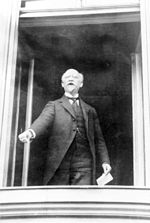
Homefront
Unexpectedly Germany plunged into World War I (1914–1918). It rapidly mobilized its civilian economy for the war effort, the was handicapped by the British blockade the cut off food supplies. Meanwhile, conditions deteriorated rapidly on the home front, with severe food shortages reported in all urban areas. Causes involved the transfer of many farmers and food workers into the military, an overburdened railroad system, shortages of coal, and the British blockade that cut off imports from abroad. The winter of 1916–1917 was known as the "turnip winter," because that vegetable, usually fed to livestock, was used by people as a substitute for potatoes and meat, which were increasingly scarce. Thousands of soup kitchens were opened to feed the hungry people, who grumbled that the farmers were keeping the food for themselves. Even the army had to cut the rations for soldiers. Morale of both civilians and soldiers continued to sink.
1918 was also the year of the deadly 1918 Spanish Flu pandemic which struck hard at a population weakened by years of malnutrition.
Revolution 1918
The end of October 1918, in Kiel, in northern Germany, saw the beginning of the German Revolution of 1918–19. Units of the German Navy refused to set sail for a last, large-scale operation in a war which they saw as good as lost, initiating the uprising. On 3 November, the revolt spread to other cities and states of the country, in many of which workers' and soldiers' councils were established. Meanwhile, Hindenburg and the senior commanders had lost confidence in the Kaiser and his government. The Kaiser and all German ruling princes abdicated. On 9 November 1918, the Social Democrat Philipp Scheidemann proclaimed a Republic.
On 11 November, the Compiègne armistice was signed, ending the war. The Treaty of Versailles was signed on 28 June 1919. Germany was to cede Alsace-Lorraine, Eupen-Malmédy, North Schleswig, and the Memel area. All German colonies were to be handed over to the British and French. Poland was restored and most of the provinces of Posen and West Prussia, and some areas of Upper Silesia were reincorporated into the reformed country after plebiscites and independence uprisings. The left and right banks of the Rhine were to be permanently demilitarised. The industrially important Saarland was to be governed by the League of Nations for 15 years and its coalfields administered by France. At the end of that time a plebiscite was to determine the Saar's future status. To ensure execution of the treaty's terms, Allied troops would occupy the left (German) bank of the Rhine for a period of 5–15 years. The German army was to be limited to 100,000 officers and men; the general staff was to be dissolved; vast quantities of war material were to be handed over and the manufacture of munitions rigidly curtailed. The navy was to be similarly reduced, and no military aircraft were allowed. Germany and its allies were to accept the sole responsibility of the war, in accordance with the War Guilt Clause, and were to pay financial reparations for all loss and damage suffered by the Allies.
Weimar Republic
Overview
The humiliating peace terms in the Treaty of Versailles provoked bitter indignation throughout Germany, and seriously weakened the new democratic regime. The greatest enemies of democracy had already been constituted. In December 1918, the Communist Party of Germany (KPD) was founded, and in 1919 it tried and failed to overthrow the new republic. Adolf Hitler in 1919 took control of the new National Socialist German Workers' Party (NSDAP), which failed in a coup in Munich in 1923. Both parties, as well as parties supporting the republic, built militant auxiliaries that engaged in increasingly violent street battles. Electoral support for both parties increased after 1929 as the Great Depression hit the economy hard, producing many unemployed men who became available for the paramilitary units. The Nazis, with a mostly rural and lower middle class base, overthrew the Weimar regime and ruled Germany in 1933–1945; the KPD, with a mostly urban and working class base, came to power (in the East) in 1945–1989.
The early years
On 11 August 1919 the Weimar constitution came into effect, with Friedrich Ebert as first President.
On 30 December 1918, the Communist Party of Germany was founded by the Spartacus League, who had split from the Social Democratic Party during the war. It was headed by Rosa Luxemburg and Karl Liebknecht, and rejected the parliamentary system. In 1920, about 300,000 members from the Independent Social Democratic Party of Germany joined the party, transforming it into a mass organization. The Communist Party had a following of about 10% of the electorate.
In the first months of 1920, the Reichswehr was to be reduced to 100,000 men, in accordance with the Treaty of Versailles. This included the dissolution of many Freikorps – units made up of volunteers. In an attempt at a coup d'état in March 1920, the Kapp Putsch, extreme right-wing politician Wolfgang Kapp let Freikorps soldiers march on Berlin and proclaimed himself Chancellor of the Reich. After four days the coup d'état collapsed, due to popular opposition and lack of support by the civil servants and the officers. Other cities were shaken by strikes and rebellions, which were bloodily suppressed.
Faced with animosity from Britain and France and the retreat of American power from Europe, in 1922 Germany was the first state to establish diplomatic relations with the new Soviet Union. Under the Treaty of Rapallo, Germany accorded the Soviet Union de jure recognition, and the two signatories mutually cancelled all pre-war debts and renounced war claims.
When Germany defaulted on its reparation payments, French and Belgian troops occupied the heavily industrialised Ruhr district (January 1923). The German government encouraged the population of the Ruhr to passive resistance: shops would not sell goods to the foreign soldiers, coal-mines would not dig for the foreign troops, trams in which members of the occupation army had taken seat would be left abandoned in the middle of the street. The passive resistance proved effective, insofar as the occupation became a loss-making deal for the French government. But the Ruhr fight also led to hyperinflation, and many who lost all their fortune would become bitter enemies of the Weimar Republic, and voters of the anti-democratic right. See 1920s German inflation.
In September 1923, the deteriorating economic conditions led Chancellor Gustav Stresemann to call an end to the passive resistance in the Ruhr. In November, his government introduced a new currency, the Rentenmark (later: Reichsmark), together with other measures to stop the hyperinflation. In the following six years the economic situation improved. In 1928, Germany's industrial production even regained the pre-war levels of 1913.
The national elections of 1924 led to a swing to the right. Field Marshal Paul von Hindenburg was elected President in 1925.
In October 1925 the Treaty of Locarno was signed by Germany, France, Belgium, Britain and Italy; it recognised Germany's borders with France and Belgium. Moreover, Britain, Italy and Belgium undertook to assist France in the case that German troops marched into the demilitarised Rheinland. Locarno paved the way for Germany's admission to the League of Nations in 1926.
Reparations
The actual amount of reparations that Germany was obliged to pay out was not the 132 billion marks decided in the London Schedule of 1921 but rather the 50 million marks stipulated in the A and B Bonds. Historian Sally Marks says the 112 billion marks in "C bonds" were entirely chimerical—a device to fool the public into thinking Germany would pay much more. The actual total payout from 1920 to 1931 (when payments were suspended indefinitely) was 20 billion German gold marks, worth about $5 billion US dollars or £1 billion British pounds. 12.5 billion was cash that came mostly from loans from New York bankers. The rest was goods like coal and chemicals, or from assets like railway equipment. The reparations bill was fixed in 1921 on the basis of an German capacity to pay, not on the basis of Allied claims. The highly publicized rhetoric of 1919 about paying for all the damages and all the veterans' benefits was irrelevant for the total, but it did determine how the recipients spent their share. Germany owed reparations chiefly to France, Britain, Italy and Belgium; the US received $100 million.
Economic collapse and political problems, 1929–1933
The stock market crash of 1929 on Wall Street marked the beginning of the worldwide Great Depression, which hit Germany as hard as any nation. In July 1931, the Darmstätter und Nationalbank – one of the biggest German banks – failed. In early 1932, the number of unemployed had soared to more than 6,000,000.
On top of the collapsing economy came a political crisis: the political parties represented in the Reichstag were unable to build a governing majority in the face of escalating extremism from the far right (the Nazis, NSDAP) and the far left (the Communists, KPD). In March 1930, President Hindenburg appointed Heinrich Brüning Chancellor. To push through his package of austerity measures against a majority of Social Democrats, Communists and the NSDAP (Nazis), Brüning made use of emergency decrees and dissolved Parliament. In March and April 1932, Hindenburg was re-elected in the German presidential election of 1932.
The NSDAP was the largest party in the national elections of 1932. On 31 July 1932 the NSDAP had received 37.3% of the votes, and in the election on 6 November 1932 it received less, but still the largest share, 33.1%, making it the biggest party in the Reichstag. The Communist KPD came third, with 15%. Together, the anti-democratic parties of far right and far left were now able to hold the majority of seats in Parliament, but they were at sword's point with each other, fighting it out in the streets. The NSDAP was particularly successful among Protestants, among unemployed young voters, among the petite bourgeoisie (lower middle class) which had lost its assets in the hyperinflation of 1923, and among the rural population. It was weakest in Catholic areas and in large cities. On 30 January 1933, pressured by former Chancellor Franz von Papen and other conservatives, President Hindenburg appointed Hitler as Chancellor.
Science and culture
The Weimar years saw a flowering of German science and high culture, before the Nazi regime resulted in a decline in the scientific and cultural life in Germany and forced many renowned scientists and writers to flee. German recipients dominated the Nobel prizes in science. Germany dominated the world of physics before 1933, led by Hermann von Helmholtz, Joseph von Fraunhofer, Daniel Gabriel Fahrenheit, Wilhelm Conrad Röntgen, Albert Einstein, Max Planck and Werner Heisenberg. Chemistry likewise was dominated by German professors and researchers at the great chemical companies such as BASF and Bayer and persons like Fritz Haber. Theoretical mathematicians included Carl Friedrich Gauss in the 19th century and David Hilbert in the 20th century. Carl Benz, the inventor of the automobile, was one of the pivotal figures of engineering.
Among the most important German writers were Thomas Mann (1875–1955), Hermann Hesse (1877–1962) and Bertolt Brecht (1898–1956). The pessimistic historian Oswald Spengler wrote The Decline of the West (198–23) on the inevitable decay of Western Civilization, and influenced intellectuals in Germany such as Martin Heidegger, Max Scheler, and the Frankfurt School, as well as intellectuals around the world.
After 1933, Nazi proponents of "Aryan physics," led by the Nobel Prize-winners Johannes Stark and Philipp Lenard, attacked Einstein's theory of relativity as a degenerate example of Jewish materialism in the realm of science. Many scientists and humanists emigrated; Einstein moved permanently to the U.S. but some of the others returned after 1945.
Nazi Germany
The Nazi regime restored economic prosperity and ended mass unemployment using heavy spending on the military, while suppressing labor unions and strikes. The return of prosperity gave the Nazi Party enormous popularity, with only minor, isolated and subsequently unsuccessful cases of resistance among the German population over the 12 years of rule. The Gestapo (secret police) under Heinrich Himmler destroyed the political opposition and persecuted the Jews, trying to force them into exile, while taking their property. The Party took control of the courts, local government, and all civic organizations except the Protestant and Catholic churches. All expressions of public opinion were controlled by Hitler's propaganda minister, Joseph Goebbels, who made effective use of film, mass rallies, and Hitler's hypnotic speaking. The Nazi state idolized Hitler as its Führer (leader), putting all powers in his hands. Nazi propaganda centered on Hitler and was quite effective in creating what historians called the "Hitler Myth"—that Hitler was all-wise and that any mistakes or failures by others would be corrected when brought to his attention. In fact Hitler had a narrow range of interests and decision making was diffused among overlapping, feuding power centers; on some issues he was passive, simply assenting to pressures from whomever had his ear. All top officials reported to Hitler and followed his basic policies, but they had considerable autonomy on a daily basis.
Establishment of the Nazi regime
In order to secure a majority for his Nazi Party in the Reichstag, Hitler called for new elections. On the evening of 27 February 1933, a fire was set in the Reichstag building. Hitler swiftly blamed an alleged Communist uprising, and convinced President Hindenburg to sign the Reichstag Fire Decree. This decree, which would remain in force until 1945, repealed important political and human rights of the Weimar constitution. Communist agitation was banned, but at this time not the Communist Party itself.
Eleven thousand Communists and Socialists were arrested and brought into hastily prepared concentration camps such as Kemna concentration camp, where they were at the mercy of the Gestapo, the newly established secret police force (9,000 were found guilty and most executed). Communist Reichstag deputies were taken into protective custody (despite their constitutional privileges).
Despite the terror and unprecedented propaganda, the last free General Elections of 5 March 1933, while resulting in 43.9% failed to bring the majority for the NSDAP that Hitler had hoped for. Together with the German National People's Party (DNVP), however, he was able to form a slim majority government. With accommodations to the Catholic Centre Party, Hitler succeeded in convincing a required two-thirds of a rigged Parliament to pass the Enabling act of 1933 which gave his government full legislative power. Only the Social Democrats voted against the Act. The Enabling Act formed the basis for the dictatorship, dissolution of the Länder; the trade unions and all political parties other than the Nazi Party were suppressed. A centralised totalitarian state was established, no longer based on the liberal Weimar constitution. Germany left the League of Nations. The coalition parliament was rigged on this fateful 23 March 1933 by defining the absence of arrested and murdered deputies as voluntary and therefore cause for their exclusion as wilful absentees. Subsequently in July the Centre Party was voluntarily dissolved in a quid pro quo with the Pope under the anti-communist Pope Pius XI for the Reichskonkordat; and by these manoeuvres Hitler achieved movement of these Catholic voters into the Nazi party, and a long-awaited international diplomatic acceptance of his regime. It is interesting to note, however, that according to Professor Dick Geary the Nazis gained a larger share of their vote in Protestant areas than in Catholic areas, in the elections held between 1928 and November 1932. The Communist Party was proscribed in April 1933. On the weekend of 30 June 1934, he gave order to the SS to seize Röhm and his lieutenants, and to execute them without trial (known as the Night of the Long Knives). Upon Hindenburg's death on 2 August 1934, Hitler's cabinet passed a law proclaiming the presidency to be vacant and transferred the role and powers of the head of state to Hitler as Führer (Leader) and Chancellor.
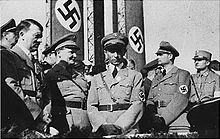
However, many leaders of the Nazi SA were disappointed. The Chief of Staff of the SA, Ernst Röhm, was pressing for the SA to be incorporated into the army. Hitler had long been at odds with Röhm and felt increasingly threatened by these plans and in the " Night of the Long Knives" in 1934 killed Röhm and the top SA leaders using their notorious homosexuality as an excuse.
The SS became an independent organisation under the command of the Reichsführer SS Heinrich Himmler. He would become the supervisor of the Gestapo and of the concentration camps, soon also of the ordinary police. Hitler also established the Waffen-SS as a separate troop.
Jews
The regime showed particular hostility towards the Jews, which were the target of unending propaganda attacks. In 1933 all Jewish civil servants and academics were fired. In September 1935, the Reichstag passed the Nuremberg race laws. Jews lost their German citizenship, and were banned from marrying non-Jewish Germans. About 500,000 individuals were affected by the new rules. About half of Germany's 500,000 Jews fled before 1939, after which escape became almost impossible.
Military
Hitler re-established the Luftwaffe (air force) and reintroduced universal military service. This was in breach of the Treaty of Versailles; Britain, France or Italy issued notes of protest. Hitler had the officers swear their personal allegiance to him. In 1936 German troops marched into the demilitarised Rhineland. Britain and France did not intervene. The move strengthened Hitler's standing in Germany. His reputation swelled further with the 1936 Summer Olympics, which were held in the same year in Berlin, and which proved another great propaganda success for the regime as orchestrated by master propagandist Joseph Goebbels.
Women
Historians have paid special attention to the efforts by Nazi Germany to reverse the gains women made before 1933, especially in the relatively liberal Weimar Republic. It appears the role of women in Nazi Germany changed according to circumstances. Theoretically the Nazis believed that women must be subservient to men, avoid careers, devote themselves to childbearing and child-rearing, and be a helpmate of the traditional dominant father in the traditional family. However, before 1933, women played important roles in the Nazi organization and were allowed some autonomy to mobilize other women. After Hitler came to power in 1933, the activist women were replaced by bureaucratic women who emphasized feminine virtues, marriage, and childbirth. As Germany prepared for war, large numbers were incorporated into the public sector and with the need for full mobilization of factories by 1943, all women were required to register with the employment office. Women's wages remained unequal and women were denied positions of leadership or control.
In 1944-45 more than 500,000 women were volunteer uniformed auxiliaries in the German armed forces (Wehrmacht). About the same number served in civil aerial defense, 400,000 volunteered as nurses, and many more replaced drafted men in the wartime economy. In the Luftwaffe they served in combat roles helping to operate the anti—aircraft systems that shot down Allied bombers.
Foreign policy
Hitler's diplomatic strategy in the 1930s was to make seemingly reasonable demands, threatening war if they were not met. When opponents tried to appease him, he accepted the gains that were offered, then went to the next target. That aggressive strategy worked as Germany pulled out of the League of Nations (1933), rejected the Versailles Treaty and began to re-arm (1935), won back the Saar (1935), remilitarized the Rhineland (1936), formed an alliance ("axis") with Mussolini's Italy (1936), sent massive military aid to Franco in the Spanish Civil War (1936–39), seized Austria (1938), took over Czechoslovakia after the British and French appeasement of the Munich Agreement of 1938, formed a peace pact with Joseph Stalin's Soviet Union in August 1939, and finally invaded Poland in September 1939. Britain and France declared war and World War II began – somewhat sooner than the Nazis expected or were ready for.
After establishing the "Rome-Berlin axis" with Benito Mussolini, and signing the Anti-Comintern Pact with Japan – which was joined by Italy a year later in 1937 – Hitler felt able to take the offensive in foreign policy. On 12 March 1938, German troops marched into Austria, where an attempted Nazi coup had been unsuccessful in 1934. When Austrian-born Hitler entered Vienna, he was greeted by loud cheers. Four weeks later, 99% of Austrians voted in favour of the annexation (Anschluss) of their country Austria to the German Reich. After Austria, Hitler turned to Czechoslovakia, where the 3.5 million-strong Sudeten German minority was demanding equal rights and self-government. At the Munich Conference of September 1938, Hitler, the Italian leader Benito Mussolini, British Prime Minister Neville Chamberlain and French Prime Minister Édouard Daladier agreed upon the cession of Sudeten territory to the German Reich by Czechoslovakia. Hitler thereupon declared that all of German Reich's territorial claims had been fulfilled. However, hardly six months after the Munich Agreement, in March 1939, Hitler used the smoldering quarrel between Slovaks and Czechs as a pretext for taking over the rest of Czechoslovakia as the Protectorate of Bohemia and Moravia. In the same month, he secured the return of Memel from Lithuania to Germany. Chamberlain was forced to acknowledge that his policy of appeasement towards Hitler had failed.
In six years, the Nazi regime prepared the country for World War II. The Nazi leadership attempted to remove or subjugate the Jewish population of Nazi Germany and later in the occupied countries through forced deportation and, ultimately, genocide now known as the Holocaust. A similar policy applied to the various ethnic and national groups considered subhuman such as Poles, Roma or Russians. These groups were seen as threats to the purity of Germany's Aryan race. There were also many groups, such as homosexuals, the mentally handicapped and those who were physically challenged from birth, which were singled out as being detrimental to Aryan purity.
World War II
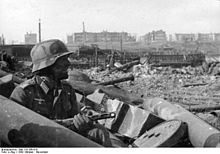
At first Germany's military moves were brilliantly successful, as in the "blitzkrieg" invasions of Poland (1939), Norway (1940), the Low Countries (1940), and above all the stunningly successful invasion and quick conquest of France in 1940. Hitler probably wanted peace with Britain in late 1940, but Prime Minister Winston Churchill, standing alone, was dogged in his defiance. Churchill had major financial, military, and diplomatic help from President Franklin D. Roosevelt in the U.S., another implacable foe of Hitler. Hitler's emphasis on maintaining high living standards postponed the full mobilization of the national economy until 1942, years after the great rivals Britain, Russia, and the U.S. had fully mobilized. Germany invaded the Soviet Union in June 1941 – weeks behind schedule – but swept forward until it reached the gates of Moscow.
The tide turned in December 1941, when the invasion of Russia stalled in cold weather and the United States joined the war. After surrender in North Africa and losing the Battle of Stalingrad in 1942–43, the Germans were on the defensive. By late 1944, the United States, Canada, France, and Great Britain were closing in on Germany in the West, while the Soviets were closing from the East. Nazi Germany collapsed as Berlin was taken by the Red Army in a fight to the death on the city streets. Hitler committed suicide on 30 April 1945. Final German surrender was signed on 8 May 1945.
By September 1945, the Third Reich (which lasted only 12 years) and its Axis partners (Italy and Japan) had been defeated, chiefly by the forces of the Soviet Union, the United States, and the United Kingdom. Much of Europe lay in ruins, over 60 million people had been killed (most of them civilians), including approximately 6 million Jews and 5 million non-Jews in what became known as the Holocaust. World War II resulted in the destruction of Germany's political and economic infrastructure and led directly to its partition, considerable loss of territory (especially in the east), and historical legacy of guilt and shame.
Germany during the Cold War
As a consequence of the defeat of Nazi Germany in 1945 and the onset of the Cold War in 1947, the country was split between the two global blocs in the East and West, a period known as the division of Germany. Millions of refugees from Central and Eastern Europe moved west, most of them to West Germany. Two states emerged: West Germany was a parliamentary democracy, a NATO member, a founding member of what since became the European Union and one of the world's largest economies, while East Germany was a totalitarian Communist dictatorship that was a satellite of Moscow. With the collapse of Communism in 1989, reunion on West Germany's terms followed.
No one doubted Germany's economic and engineering prowess; the question was how long bitter memories of the war would cause Europeans to distrust Germany, and whether Germany could demonstrate it had rejected totalitarianism and militarism and embraced democracy and human rights.
Post-war chaos
The total of German war dead was 8% to 10% out of a prewar population of 69,000,000, or between 5.5 million and 7 million people. This included 4.5 million in the military, and between 1 and 2 million civilians. There was chaos as 11 million foreign workers and POWs left, while 14 million displaced refugees from the east and soldiers returned home.
At the Potsdam Conference, Germany was divided into four military occupation zones by the Allies and did not regain independence until 1949. The provinces east of the Oder and Neisse rivers (the Oder-Neisse line) were transferred to Poland, Lithuania, and Russia ( Kaliningrad oblast); the 6.7 million Germans living in Poland and the 2.5 million in Czechoslovakia were forced to move west, although most had already left when the war ended.
Denazification removed, imprisoned, or executed most top officials of the old regime, but most middle and lower ranks of civilian officialdom were not seriously affected. In accordance with the Allied agreement made at the Yalta conference millions of POWs were used as forced labor by the Soviet Union and other European countries.
In the East, the Soviets crushed dissent and imposed another police state, often employing ex-Nazis in the dreaded Stasi. The Soviets extracted about 23% of the East German GNP for reparations, while in the West reparations were a minor factor.
In 1945–46 housing and food conditions were bad, as the disruption of transport, markets, and finances slowed a return to normal. In the West, bombing had destroyed the fourth of the housing stock, and over 10 million refugees from the east had crowded in, most living in camps. Food production in 1946–48 was only two-thirds of the prewar level, while grain and meat shipments – which usually supplied 25% of the food – no longer arrived from the East. Furthermore, the end of the war brought the end of large shipments of food seized from occupied nations that had sustained Germany during the war. Coal production was down 60%, which had cascading negative effects on railroads, heavy industry, and heating. Industrial production fell more than half and reached prewar levels only at the end of 1949.
Allied economic policy originally was one of industrial disarmament plus building the agricultural sector. In the western sectors, most of the industrial plants had minimal bomb damage and the Allies dismantled 5% of the industrial plants for reparations.
However, deindustrialization became impractical and the U.S. instead called for a strong industrial base in Germany so it could stimulate European economic recovery. The U.S. shipped food in 1945–47 and made a $600 million loan in 1947 to rebuild German industry. By May 1946 the removal of machinery had ended, thanks to lobbying by the U.S. Army. The Truman administration finally realised that economic recovery in Europe could not go forward without the reconstruction of the German industrial base on which it had previously been dependent. Washington decided that an "orderly, prosperous Europe requires the economic contributions of a stable and productive Germany."
East Germany (GDR)

In 1949 the Soviet zone became the "Deutsche Demokratische Republik" – "DDR" ("German Democratic Republic" – "GDR", simply often "East Germany"), under control of the German Communist Party. Neither country had a significant army until the 1950s, but East Germany built the Stasi into a powerful secret police that infiltrated every aspect of the society.
East Germany was an Eastern bloc state under political and military control of the Soviet Union through her occupation forces and the Warsaw Treaty. Political power was solely executed by leading members ( Politburo) of the communist-controlled Socialist Unity Party (SED). A Soviet-style command economy was set up; later the GDR became the most advanced Comecon state. While East German propaganda was based on the benefits of the GDR's social programs and the alleged constant threat of a West German invasion, many of her citizens looked to the West for political freedoms and economic prosperity.
Walter Ulbricht (1893–1973) was the party boss from 1950 to 1971. In 1933, Ulbricht had fled to Moscow, where he served as a Comintern agent loyal to Stalin. As World War II was ending, Stalin assigned him the job of designing the postwar German system that would centralize all power in the Communist Party. Ulbricht became deputy prime minister in 1949 and secretary (chief executive) of the Socialist Unity (Communist) party in 1950. Some 2.6 million people had fled East Germany by 1961 when he built the Berlin Wall to stop them — shooting those who attempted it. What the GDR called the "Anti-Fascist Protective Wall" was a major embarrassment for the program during the Cold War, but it did stabilize East Germany and postpone its collapse. Ulbricht lost power in 1971, but was kept on as a nominal head of state. He was replaced because he failed to solve growing national crises, such as the worsening economy in 1969–70, the fear of another popular uprising as had occurred in 1953, and the disgruntlement between Moscow and Berlin caused by Ulbricht's détente policies toward the West.
The transition to Erich Honecker ( General Secretary from 1971 to 1989) led to a change in the direction of national policy and efforts by the Politburo to pay closer attention to the grievances of the proletariat. Honecker's plans were not successful, however, with the dissent growing among East Germany's population.
In 1989, the socialist regime collapsed after 40 years, despite its omnipresent secret police, the Stasi. Main reasons for the collapse include severe economic problems and growing emigration towards the West.
East Germany's culture was shaped by Communism and particularly Stalinism. It was characterized by East German psychoanalyst Hans-Joachim Maaz in 1990 as having produced a "Congested Feeling" among Germans in the East as a result of Communist policies criminalizing personal expression that deviates from government approved ideals, and through the enforcement of Communist principals by physical force and intellectual repression by government agencies, particularly the Stasi. Critics of the East German state have claimed that the state's commitment to communism was a hollow and cynical tool of a ruling elite. This argument has been challenged by some scholars who claim that the Party was committed to the advance of scientific knowledge, economic development, and social progress. However, the vast majority regarded the state's Communist ideals to be a nothing more than a deceptive method for government control.
According to German historian Jürgen Kocka (2010):
- Conceptualizing the GDR as a dictatorship has become widely accepted, while the meaning of the concept dictatorship varies. Massive evidence has been collected that proves the repressive, undemocratic, illiberal, nonpluralistic character of the GDR regime and its ruling party.
West Germany
In 1949, the three western occupation zones (American, British, and French) were combined into the Federal Republic of Germany (FRG, West Germany). The government was formed under Chancellor Konrad Adenauer and his conservative CDU/CSU coalition. The CDU/CSU was in power during most of the period since 1949. The capital was Bonn until it was moved to Berlin in 1990. In 1990 FRG absorbed East Germany and gained full sovereignty over Berlin. At all points West Germany was much larger and richer that East Germany, which became a dictatorship under the control of the Communist Party and was closely monitored by Moscow. Germany, especially Berlin, was a cockpit of the Cold War, with NATO and the Warsaw Pact assembling major military forces in west and east. However there was never any combat.
Economic miracle
West Germany enjoyed prolonged economic growth beginning in the early 1950s ( Wirtschaftswunder or "Economic Miracle"). Industrial production doubled from 1950 to 1957, and gross national product grew at a rate of 9 or 10% per year, providing the engine for economic growth of all of Western Europe. Labor union supported the new policies with postponed wage increases, minimized strikes, support for technological modernization, and a policy of co-determination (Mitbestimmung), which involved a satisfactory grievance resolution system as well as requiring representation of workers on the boards of large corporations. The recovery was accelerated by the currency reform of June 1948, U.S. gifts of $1.4 billion as part of the Marshall Plan, the breaking down of old trade barriers and traditional practices, and the opening of the global market. West Germany gained legitimacy and respect, as it shed the horrible reputation Germany had gained under the Nazis.
West Germany played a central role in the creation of European cooperation; it joined NATO in 1955 and was a founding member of the European Economic Community in 1958.
1948 currency reform
The most dramatic and successful policy event was the currency reform of 1948. Since the 1930s, prices and wages had been controlled, but money had been plentiful. That meant that people had accumulated large paper assets, and that official prices and wages did not reflect reality, as the black market dominated the economy and more than half of all transactions were taking place unofficially. On 21 June 1948, the Western Allies withdrew the old currency and replaced it with the new Deutsche Mark at the rate of 1 new per 10 old. This wiped out 90% of government and private debt, as well as private savings. Prices were decontrolled, and labor unions agreed to accept a 15% wage increase, despite the 25% rise in prices. The result was that prices of German export products held steady, while profits and earnings from exports soared and were poured back into the economy. The currency reforms were simultaneous with the $1.4 billion in Marshall Plan money coming in from the United States, which was used primarily for investment.
In addition, the Marshall Plan forced German companies, as well as those in all of Western Europe, to modernize their business practices and take account of the international market. Marshall Plan funding helped overcome bottlenecks in the surging economy caused by remaining controls (which were removed in 1949), and Marshall Plan business reforms opened up a greatly expanded market for German exports. Overnight, consumer goods appeared in the stores, because they could be sold for realistic prices, emphasizing to Germans that their economy had turned a corner.
The success of the currency reform angered the Soviets, who cut off all road, rail, and canal links between the western zones and West Berlin. This was the Berlin Blockade, which lasted from 24 June 1948 to 12 May 1949. In response, the U.S. and Britain launched an airlift of food and coal and distributed the new currency in West Berlin as well. The city thereby became economically integrated into West Germany.
Adenauer
Konrad Adenauer (1876–1967) was the dominant leader in West Germany. He was the first chancellor (top official) of the FRG, 1949–63, and until his death was the founder and leader of the Christian Democratic Union (CDU), a coalition of conservatives, ordoliberals, and adherents of Protestant and Catholic social teaching that dominated West Germany politics for most of its history. During his chancellorship, the West Germany economy grew quickly, and West Germany established friendly relations with France, participated in the emerging European Union, established the country's armed forces (the Bundeswehr), and became a pillar of NATO as well as firm ally of the United States. Adenauer's government also commenced the long process of reconciliation with the Jews and Israel after the Holocaust.
Erhard
Ludwig Erhard (1897–1977) was in charge of economic policy as economics director for the British and American occupation zones and was Adenauer's long-time economics minister. Erhard's decision to lift many price controls in 1948 (despite opposition from both the social democratic opposition and Allied authorities), plus his advocacy of free markets, helped set the Federal Republic on its strong growth from wartime devastation. Norbert Walter, a former chief economist at Deutsche Bank, argues that "Germany owes its rapid economic advance after World War II to the system of the Social Market Economy, established by Ludwig Erhard." Erhard was politically less successful when he served as the CDU Chancellor from 1963 until 1966. Erhard followed the concept of a social market economy, and was in close touch with professional economists. Erhard viewed the market itself as social and supported only a minimum of welfare legislation. However, Erhard suffered a series of decisive defeats in his effort to create a free, competitive economy in 1957; he had to compromise on such key issues as the anti-cartel legislation. Thereafter, the West German economy evolved into a conventional west European welfare state.
Meanwhile in adopting the Godesberg Program in 1959, the Social Democratic Party of Germany (SPD) largely abandoned Marxism ideas and embraced the concept of the market economy and the welfare state. Instead it now sought to move beyond its old working class base to appeal the full spectrum of potential voters, including the middle class and professionals. Labor unions cooperated increasingly with industry, achieving labor representation on corporate boards and increases in wages and benefits.
Grand coalition
In 1966 Erhard lost support and Kurt Kiesinger (1904–1988) was elected as Chancellor by a new CDU/CSU- SPD alliance combining the two largest parties. Socialist (SPD) leader Willy Brandt was Deputy Federal Chancellor and Foreign Minister. The Grand Coalition lasted 1966–69 and is best known for reducing tensions with the Soviet bloc nations and establishing diplomatic relations with Czechoslovakia, Romania and Yugoslavia.
Guest workers
With a booming economy short of unskilled workers, especially after the Berlin Wall cut off the steady flow of East Germans, the FRG negotiated migration agreements with Italy (1955), Spain (1960), Greece (1960), and Turkey (1961) that brought in hundreds of thousands of temporary guest workers, called Gastarbeiter. In 1968 the FRG signed a guest worker agreement with Yugoslavia that employed additional guest workers. Gastarbeiter were young men who were paid full-scale wages and benefits, but were expected to return home in a few years.
The agreement with Turkey ended in 1973 but few workers returned because there were few good jobs in Turkey. By 2010 there were about 4 million people of Turkish descent in Germany. The generation born in Germany attended German schools, but had a poor command of either German or Turkish, and had either low-skilled jobs or were unemployed.
Brandt and Ostpolitik
Willy Brandt (1913–1992) was the leader of the Social Democratic Party in 1964–87 and West German Chancellor in 1969–1974. Under his leadership, the German government sought to reduce tensions with the Soviet Union and improve relations with the German Democratic Republic, a policy known as the Ostpolitik. Relations between the two German states had been icy at best, with propaganda barrages in each direction. The heavy outflow of talent from East Germany prompted the building of the Berlin Wall in 1961, which worsened Cold War tensions and prevented East Germans from travel. Although anxious to relieve serious hardships for divided families and to reduce friction, Brandt's Ostpolitik was intent on holding to its concept of "two German states in one German nation."
Ostpolitik was opposed by the conservative elements in Germany, but won Brandt an international reputation and the Nobel Peace Prize in 1971. In September 1973, both West and East Germany were admitted to the United Nations. The two countries exchanged permanent representatives in 1974, and, in 1987, East Germany's leader Erich Honecker paid an official state visit to West Germany.
Economic crisis of 1970s
After 1973, Germany was hard hit by a worldwide economic crisis, soaring oil prices, and stubbornly high unemployment, which jumped from 300,000 in 1973 to 1.1 million in 1975. The Ruhr region was hardest hit, as its easy-to-reach coal mines petered out, and expensive German coal was no longer competitive. Likewise the Ruhr steel industry went into sharp decline, as its prices were undercut by lower-cost suppliers such as Japan. The welfare system provided a safety net for the large number of unemployed workers, and many factories reduce their labor force and began to concentrate on high-profit specialty items. After 1990 the Ruhr moved into service industries and high technology. Cleaning up the heavy air and water pollution became a major industry in its own right. Meanwhile, formerly rural Bavaria became a high-tech centre of industry.
A spy scandal forced Brandt to step down as Chancellor while remaining as party leader. He was replaced by Helmut Schmidt (b. 1918), of the SPD, who served as Chancellor in 1974–1982. Schmidt continued the Ostpolitik with less enthusiasm. He had a PhD in economics and was more interested in domestic issues, such as reducing inflation. The debt grew rapidly as he borrowed to cover the cost of the ever more expensive welfare state. After 1979, foreign policy issues grew central as the Cold War turned hot again. The German peace movement mobilized hundreds of thousands of demonstrators to protest against American deployment in Europe of new medium-range ballistic missiles. Schmidt supported the deployment but was opposed by the left wing of the SPD and by Brandt.
The pro-business Free Democratic Party (FDP) had been in coalition with the SPD, but now it changed direction. Led by Finance Minister Otto Graf Lambsdorff (1926–2009) the FDP adopted the market-oriented "Kiel Theses" in 1977; it rejected the Keynesian emphasis on consumer demand, and proposed to reduce social welfare spending, and try to introduce policies to stimulate production and facilitate jobs. Lambsdorff argued that the result would be economic growth, which would itself solve both the social problems and the financial problems. As a consequence, the FDP switched allegiance to the CDU and Schmidt lost his parliamentary majority in 1982. For the only time in West Germany's history, the government fell on a vote of no confidence.
Kohl
Helmut Kohl (b. 1930) brought the conservatives back to power with a CDU/CSU-FDP coalition in 1982, and served as Chancellor until 1998. After repeated victories in 1983, 1987, 1990 and 1994 he was finally defeated by a landslide that was the biggest on record, for the left in the 1998 federal elections, and was succeeded as Chancellor by Gerhard Schröder of the SPD. Kohl is best known for orchestrating reunification with the approval of all the Four Powers from World War II, who still had a voice in German affairs.
Reunification
During the summer of 1989, rapid changes known as peaceful revolution or Die Wende took place in East Germany, which quickly led to German reunification. Growing numbers of East Germans emigrated to West Germany, many via Hungary after Hungary's reformist government opened its borders. Thousands of East Germans also tried to reach the West by staging sit-ins at West German diplomatic facilities in other East European capitals, most notably in Prague. The exodus generated demands within East Germany for political change, and mass demonstrations in several cities continued to grow.
Unable to stop the growing civil unrest, Erich Honecker was forced to resign in October, and on 9 November, East German authorities unexpectedly allowed East German citizens to enter West Berlin and West Germany. Hundreds of thousands of people took advantage of the opportunity; new crossing points were opened in the Berlin Wall and along the border with West Germany. This led to the acceleration of the process of reforms in East Germany that ended with the German reunification that came into force on 3 October 1990.
Recent history (1990 to present)
Schröder
The SPD in coalition with the Greens won the elections of 1998. SPD leader Gerhard Schröder positioned himself as a centrist " Third Way" candidate in the mold of Britain's Tony Blair and America's Bill Clinton.
Schröder, in March 2003, reversed his position and proposed a significant downsizing of the welfare state, known as Agenda 2010. He had enough support to overcome opposition from the trade unions and the SPD's left wing. Agenda 2010 had five goals: tax cuts; labor market deregulation, especially relaxing rules protecting workers from dismissal and setting up Hartz concept job training; modernizing the welfare state by reducing entitlements; decreasing bureaucratic obstacles for small businesses; and providing new low-interest loans to local governments.
Merkel

From 2005 to 2009, Germany was ruled by a grand coalition led by the CDU's Angela Merkel as chancellor. Since the 2009 elections, Merkel has headed a centre-right government of the CDU/CSU and FDP.
Together with France and other EU states, Germany has played the leading role in the European Union. Germany (especially under Chancellor Helmut Kohl) was one of the main supporters of admitting many East European countries to the EU. Germany is at the forefront of European states seeking to exploit the momentum of monetary union to advance the creation of a more unified and capable European political, defence and security apparatus. German Chancellor Schröder expressed an interest in a permanent seat for Germany in the UN Security Council, identifying France, Russia, and Japan as countries that explicitly backed Germany's bid. Germany formally adopted the Euro on 1 January 1999 after permanently fixing the Deutsche Mark rate on 21 December 1998.
Since 1990, the German Bundeswehr has participated in a number of peacekeeping and disaster relief operations abroad. Since 2002, German troops formed part of the International Security Assistance Force in the war in Afghanistan, resulting in the first German casualties in combat missions since World War II.
In the worldwide economic recession that began in 2008, Germany did relatively well. However, the economic instability of Greece and several other EU nations in 2010–11 forced Germany to reluctantly sponsor a massive financial rescue.
In the wake of the disaster to the nuclear industry in Japan following its 2011 earthquake and tsunami, German public opinion turned sharply against nuclear power in Germany, which produces a fourth of the electricity supply. In response Merkel has announced plans to close down the nuclear system over the next decade, and to rely even more heavily on wind and other alternative energy sources, in addition to coal and natural gas. For further information, see Germany in 2011.
Historiography
Sonderweg debate
A major historiographical debate about the German history concerns the Sonderweg, the alleged “special path” that separated German history from the normal course of historical development, and whether or not Nazi Germany was the inevitable result of the Sonderweg. Proponents of the Sonderweg theory such as Fritz Fischer point to such events of the Revolution of 1848, the authoritarianism of the Second Empire and the continuation of the Imperial elite into the Weimar and Nazi periods. Opponents such as Gerhard Ritter of the Sonderweg theory argue that proponents of the theory are guilty of seeking selective examples, and there was much contingency and chance in German history. In addition, there was much debate within the supporters of the Sonderweg concept as for the reasons for the Sonderweg, and whether or not the Sonderweg ended in 1945. Was there a Sonderweg? Winkler says:
- "For a long time, educated Germans answered it in the positive, initially by laying claim to a special German mission, then, after the collapse of 1945, by criticizing Germany's deviation from the West. Today, the negative view is predominant. Germany did not, according to the now prevailing opinion, differ from the great European nations to an extent that would justify speaking of a 'unique German pa.' And, in any case, no country on earth ever took what can be described as the 'normal path.'"
Historians: Past scholars in Germany
- Johann Gustav Droysen (1808–1884)
- Johann Gottlieb Fichte (1762–1814)
- Johann Gottfried Herder (1744–1803)
- Karl Lamprecht (1856–1945)
- Gottfried Leibniz (1646–1716)
- Karl Marx (1818–1883)
- Samuel von Pufendorf (1632–1694)
- Leopold von Ranke (1795–1886)
- Friedrich Carl von Savigny (1779–1861)
- German Historical School
- Beatus Rhenanus (also known as Beatus Bild) (1485–1547)
- Heinrich von Treitschke (1834–1896)
Historians: 20th century scholars in Germany
- Bielefeld School – quantitative social history
- Martin Broszat – Nazi era
- Werner Conze
- Fritz Fischer – World War I
- Klaus Hildebrand
- Andreas Hillgruber
- Historikerstreit - debate in 1980s re Nazis, Soviets and totalitarianism
- Eberhard Jäckel – Nazi era
- Jürgen Kocka – Bielefeld school; social history
- Hartmut Kaelble
- Friedrich Meinecke (1862–1954)
- Hans Mommsen
- Wolfgang Mommsen
- Thomas Nipperdey (1927–1992) – 1800 to 1918
- Ernst Nolte
- Detlev Peukert
- Gerhard Ritter
- Oswald Spengler – world history
- Michael Stürmer − 20c; geography
- Klemens von Klemperer – Nazi era
- Hans-Ulrich Wehler – Bielefeld School; new social history; 19c
- Michael Wolffsohn
- Rainer Zitelmann – Nazi era
Historians: Outside Germany
- Thomas Carlyle (1795–1881) – Frederick the Great
- Alan Bullock – Hitler
- Gordon A. Craig – Army, politics
- Richard J. Evans – Nazi era (in The Third Reich Trilogy: The Coming of the Third Reich, The Third Reich in Power, and The Third Reich at War)
- Ian Kershaw, Hitler
- Claudia Koonz – Women in Nazi era
- Timothy Mason - Nazis
- George Mosse - 19c-20c culture
- Steven Ozment - Reformation
- Hans Rothfels – military
- Fritz Stern – cultural
- Henry Ashby Turner – 20c esp business
Historians: Holocaust
- Yehuda Bauer
- Martin Broszat
- Christopher Browning
- Lucy Dawidowicz
- Norman Finkelstein
- Henry Friedlander
- Saul Friedländer
- Daniel Goldhagen
- Raul Hilberg
- Michael Marrus
- Hans Mommsen
- R. J. Rummel

